Bangladesh
Bangladesh (/ˌbæŋləˈdɛʃ/,[14] Bengali: বাংলাদেশ, pronounced [ˈbaŋlaˌdeʃ] (![]()
People's Republic of Bangladesh
| |
|---|---|
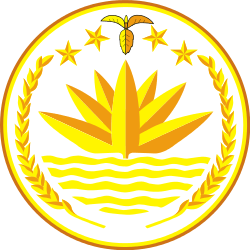 Emblem
| |
.svg.png) | |
| Capital and largest city | Dhaka 23°45′50″N 90°23′20″E |
| Official language and national language | Bengali[2] |
| Ethnic groups (2011[3]) | |
| Religion (2011[4]) | |
| Demonym(s) | Bangladeshi |
| Membership | UN, WTO, SAARC, BIMSTEC, IMCTC, OIC, Commonwealth of Nations |
| Government | Unitary dominant-party parliamentary constitutional republic |
| Abdul Hamid | |
| Sheikh Hasina | |
| Shirin Chaudhury | |
| Syed Mahmud Hossain | |
| Legislature | Jatiya Sangsad |
Independence from Pakistan | |
• Declared | 26 March 1971 |
• V-Day | 16 December 1971 |
| 16 December 1972 | |
| Area | |
• Total | 148,460[6] km2 (57,320 sq mi) (92nd) |
• Water (%) | 6.4 |
| Population | |
• 2018 estimate | |
• 2011 census | 149,772,364[9] (8th) |
• Density | 1,106/km2 (2,864.5/sq mi) (7th) |
| GDP (PPP) | 2020 estimate |
• Total | |
• Per capita | |
| GDP (nominal) | 2020 estimate |
• Total | |
• Per capita | |
| Gini (2016) | 32.4[12] medium |
| HDI (2018) | medium · 135th |
| Currency | Bangladeshi taka (৳) (BDT) |
| Time zone | UTC+6 (BST) |
| Date format | dd-mm-yyyy AD |
| Driving side | left |
| Calling code | +880 |
| ISO 3166 code | BD |
| Internet TLD | .bd .বাংলা |
Website bangladesh | |
Bangladesh forms the larger and eastern part of the Bengal region.[16] According to the ancient sacred Indian texts, Ramayana and Mahabharata, the Vanga Kingdom, one of the namesakes of the Bengal region, was a strong naval ally of the legendary Ayodhya. In the ancient and classical period of the Indian subcontinent, the territory was home to many principalities, including the Pundra, Gangaridai, Gauda, Samatata and Harikela. It was also a Mauryan province under the reign of Ashoka. The principalities were notable for their overseas trade, contacts with the Roman world, export of fine muslin and silk to the Middle East, and spreading of philosophy and art to Southeast Asia. The Pala Empire, the Chandra dynasty, and the Sena dynasty were the last pre-Islamic Bengali middle kingdoms. Islam was introduced during the Pala Empire, through trade with the Abbasid Caliphate,[17] but following the early conquest of Bakhtiyar Khalji and the subsequent establishment of the Delhi Sultanate and preaching of Shah Jalal in East Bengal, the faith fully spread across the region. In 1576, the wealthy Bengal Sultanate was absorbed into the Mughal Empire, but its rule was briefly interrupted by the Suri Empire. Following the death of Emperor Aurangzeb in the early 1700s, the proto-industrialised Mughal Bengal became a semi-independent state under the Nawabs of Bengal. The region was later conquered by the British East India Company at the Battle of Plassey in 1757.[18]
The borders of modern Bangladesh were established with the separation of Bengal and India in August 1947, when the region became East Pakistan as a part of the newly formed Dominion of Pakistan, demarcated by the Boundary of the Partition of India.[19] Later the rise of a pro-democracy movement thrived on Bengali nationalism and self-determination, leading to the Liberation War and eventually resulted in the emergence of Bangladesh as a sovereign and independent nation in 1971.
Bangladesh is the only country in the world that was created on the basis of language and ethnicity.[20][21] The Bengalis make up 98% of the total population of Bangladesh,[2][3] making it one of the most ethnically homogeneous states in the world.[22][23] The large Muslim population of Bangladesh makes it the third-largest Muslim-majority country.[24] The constitution declares Bangladesh a secular state, while establishing Islam as a state religion.[5] As a middle power in world politics,[25] Bangladesh is a unitary parliamentary democracy and constitutional republic following the Westminster system of governance. The country is divided into eight administrative divisions and sixty-four districts. Although the country continues to face the challenges of the Rohingya refugee crisis,[26] corruption,[27] and the adverse effects of climate change.[28] Bangladesh is one of the emerging and growth-leading economies of the world, and is also one of the Next Eleven countries, with one of the fastest real GDP growth rates. The Bangladeshi economy is the 39th-largest in the world by nominal GDP, and the 29th-largest by PPP.
Etymology
The exact origin of the word Bangla is unknown, though it is believed to come from "Vanga", an ancient kingdom and geopolitical division on the Ganges delta in the Indian subcontinent. It was located in southern Bengal, with the core region including present-day southern West Bengal (India) and southwestern Bangladesh. In Islamic tradition, it is said to come from "Bung/Bang", a son of Hind (the son of Hām, who was a son of Noah) who colonised the area for the first time.[29] The suffix "al" came to be added to it from the fact that the ancient rajas of this land raised mounds of earth 10 feet high and 20 in breadth in lowlands at the foot of the hills which were called "al". From this suffix added to the Bung, the name Bengal arose and gained currency".[30][31] Support to this view is found in Ghulam Husain Salim's Riyaz-us-Salatin.[29]
Other theories point to a Bronze Age proto-Dravidian tribe,[32] the Austric word "Bonga" (Sun god),[33] and the Iron Age Vanga Kingdom.[33] The Indo-Aryan suffix Desh is derived from the Sanskrit word deśha, which means "land" or "country". Hence, the name Bangladesh means "Land of Bengal" or "Country of Bengal".[34]
The term Bangla denotes both the Bengal region and the Bengali language. The earliest known usage of the term is the Nesari plate in 805 AD. The term Vangaladesa is found in 11th-century South Indian records.[34][35] The term gained official status during the Sultanate of Bengal in the 14th century.[36][37] Shamsuddin Ilyas Shah proclaimed himself as the first "Shah of Bangala" in 1342.[36] The word Bangla became the most common name for the region during the Islamic period. The Portuguese referred to the region as Bengala in the 16th century.[38] The term Bangladesh was often written as two words, Bangla Desh, in the past. Starting in the 1950s, Bengali nationalists used the term in political rallies in East Pakistan.
History
Early and medieval periods
.png)
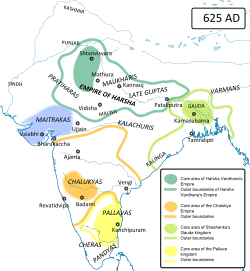
Stone Age tools found in Bangladesh indicate human habitation for over 20,000 years,[39] and remnants of Copper Age settlements date back 4,000 years.[39] Ancient Bengal was settled by Austroasiatics, Tibeto-Burmans, Dravidians and Indo-Aryans in consecutive waves of migration.[39][40] Archaeological evidence confirms that by the second millennium BCE, rice-cultivating communities inhabited the region. By the 11th century people lived in systemically-aligned housing, buried their dead, and manufactured copper ornaments and black and red pottery.[41] The Ganges, Brahmaputra and Meghna rivers were natural arteries for communication and transportation,[41] and estuaries on the Bay of Bengal permitted maritime trade. The early Iron Age saw the development of metal weaponry, coinage, agriculture and irrigation.[41] Major urban settlements formed during the late Iron Age, in the mid-first millennium BCE,[42] when the Northern Black Polished Ware culture developed.[43] In 1879, Alexander Cunningham identified Mahasthangarh as the capital of the Pundra Kingdom mentioned in the Rigveda.[44][45] The oldest inscription in Bangladesh was found in Mahasthangarh and dates from the 3rd century BCE. It is written in the Brahmi script.[46]
Greek and Roman records of the ancient Gangaridai Kingdom, which (according to legend) deterred the invasion of Alexander the Great, are linked to the fort city in Wari-Bateshwar.[47][48] The site is also identified with the prosperous trading center of Souanagoura listed on Ptolemy's world map.[49] Roman geographers noted a large seaport in southeastern Bengal, corresponding to the present-day Chittagong region.[50]

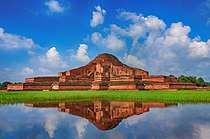
Ancient Buddhist and Hindu states which ruled Bangladesh included the Vanga, Samatata and Pundra kingdoms, the Mauryan and Gupta Empires, the Varman dynasty, Shashanka's kingdom, the Khadga and Candra dynasties, the Pala Empire, the Sena dynasty, the Harikela kingdom and the Deva dynasty. These states had well-developed currencies, banking, shipping, architecture and art, and the ancient universities of Bikrampur and Mainamati hosted scholars and students from other parts of Asia. Xuanzang of China was a noted scholar who resided at the Somapura Mahavihara (the largest monastery in ancient India), and Atisa travelled from Bengal to Tibet to preach Buddhism. The earliest form of the Bengali language began to the emerge during the eighth century.Early Muslim explorers and missionaries arrived in Bengal late in the first millennium CE. The Islamic conquest of Bengal began with the 1204 invasion by Muhammad bin Bakhtiyar Khalji;[41] after annexing Bengal to the Delhi Sultanate, Khilji waged a military campaign in Tibet. Bengal was ruled by the Delhi Sultanate for a century by governors from the Mamluk, Balban and Tughluq dynasties.
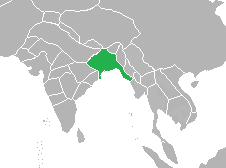
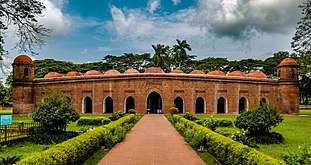
Subsequently, the independent Bengal Sultanate was established by the rebel governors in 1352. During their rule Bengal was transformed into a cosmopolitan Islamic superpower and became a major trading nation in the world, often referred by the Europeans as the richest country to trade with.[51] The sultanate's ruling houses included the Ilyas Shahi, Ganesha, Hussain Shahi, Suri and Karrani dynasties, and the era saw the introduction of a distinct mosque architecture[52] and the tangka currency. The Arakan region was brought under Bengali hegemony. The Bengal Sultanate was visited by explorers Ibn Battuta, Admiral Zheng He and Niccolo De Conti. The Khorasanis referred to the land as an "inferno full of gifts", due to its unbearable climate but abundance of wealth.[53] During the late 16th century, the Baro-Bhuyan (a confederation of Muslim and Hindu aristocrats) ruled eastern Bengal; its leader was the Mansad-e-Ala,[54] a title held by Isa Khan and his son Musa Khan. The Khan dynasty are considered local heroes for resisting North Indian invasions with their river navies.

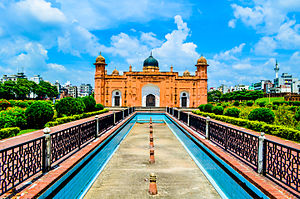
The Mughal Empire controlled Bengal by the 17th century. During the reign of Emperor Akbar, the Bengali agrarian calendar was reformed to facilitate tax collection. The Mughals established Dhaka as a fort city and commercial metropolis, and it was the capital of Bengal Subah for 75 years.[55] In 1666, the Mughals expelled the Arakanese from Chittagong. Mughal Bengal attracted foreign traders for its muslin and silk goods, and the Armenians were a notable merchant community. A Portuguese settlement in Chittagong flourished in the southeast, and a Dutch settlement in Rajshahi existed in the north. Bengal accounted for 40% of overall Dutch imports from Asia; including more than 50% of textiles and around 80% of silks.[56] The Bengal Subah, described as the Paradise of the Nations,[57] was the empire's wealthiest province, and a major global exporter,[56][58][59] a notable center of worldwide industries such as muslin, cotton textiles, silk,[41] and shipbuilding.[60] Its citizens also enjoyed one of the world's most superior living standards.[61][62]
During the 18th century, the Nawabs of Bengal became the region's de facto rulers. The title of the ruler is popularly known as the Nawab of Bengal, Bihar and Orissa, given that the Bengali Nawab's realm encompassed much of the eastern subcontinent. The Nawabs forged alliances with European colonial companies, which made the region relatively prosperous early in the century. Bengal accounted for 50% of the gross domestic product of the empire. The Bengali economy relied on textile manufacturing, shipbuilding, saltpetre production, craftsmanship and agricultural produce. Bengal was a major hub for international trade – silk and cotton textiles from Bengal were worn in Europe, Japan, Indonesia and Central Asia.[63][41] Annual Bengali shipbuilding output was 223,250 tons, compared to an output of 23,061 tons in the nineteen colonies of North America. Bengali shipbuilding proved to be more advanced than European shipbuilding prior to the Industrial Revolution. The flush deck of Bengali rice ships was later replicated in European shipbuilding to replace the stepped deck design for ship hulls.[64][65][66][67][68][69]
The Bengali Muslim population was a product of conversion and religious evolution,[41] and their pre-Islamic beliefs included elements of Buddhism and Hinduism. The construction of mosques, Islamic academies (madrasas) and Sufi monasteries (khanqahs) facilitated conversion, and Islamic cosmology played a significant role in developing Bengali Muslim society. Scholars have theorised that Bengalis were attracted to Islam by its egalitarian social order, which contrasted with the Hindu caste system.[70] One of the notable Muslim preachers was Shah Jalal who arrived in the region of Sylhet in 1303 with many other disciples to preach the religion to the people. By the 15th century, Muslim poets were writing in the Bengali language. Notable medieval Bengali Muslim poets included Daulat Qazi, Abdul Hakim and Alaol. Syncretic cults, such as the Baul movement, emerged on the fringes of Bengali Muslim society. The Persianate culture was significant in Bengal, where cities like Sonargaon became the easternmost centers of Persian influence.[71][72]
The Mughals had aided France during the Seven Years' War to avoid losing the Bengal region to the British. However, in the Battle of Plassey the British East India Company registered a decisive victory over the Nawab of Bengal and his French[73] allies on 22 June 1757, under the leadership of Robert Clive. The battle followed the order of Siraj-ud-Daulah, the last independent Nawab of Bengal, to the English to stop the extension of their fortification. Robert Clive bribed Mir Jafar, the commander-in-chief of the Nawab's army, and also promised him to make him Nawab of Bengal which helped him to defeat Siraj-ud-Daulah and capture Calcutta.[74] The battle consolidated the company's presence in Bengal, which later expanded to cover much of India over the next hundred years. Although they had lost control of Bengal Subah, Shah Alam II was involved in the Bengal War which ended once more in their defeat at the Battle of Buxar.[75]
Colonial period
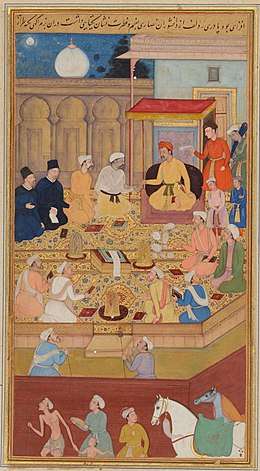
Two decades after Vasco Da Gama's landing in Calicut, the Bengal Sultanate gave permission for the Portuguese settlement in Chittagong to be established in 1528. It became the first European colonial enclave in Bengal. The Bengal Sultanate lost control of Chittagong in 1531 after Arakan declared independence and the established Kingdom of Mrauk U. This altered geopolitical landscape allowed the Portuguese unhindered control of Chittagong for over a century.
Portuguese ships from Goa and Malacca began frequenting the port city in the 16th century. The cartaz system was introduced and required all ships in the area to purchase naval trading licenses from the Portuguese settlement. Slave trade and piracy flourished. The nearby island of Sandwip was conquered in 1602. In 1615, the Portuguese Navy defeated a joint Dutch East India Company and Arakanese fleet near the coast of Chittagong.
Since at least 1515 the Portuguese were in Bengal as traders, and later in 1521 an embassy was sent to Gaur to be able to create factories in the region. The Bengal Sultan after 1534 allowed the Portuguese to create several settlements at Chitagoong, Satgaon,[76] Hughli, Bandel, and Dhaka. In 1535 the Portuguese allied with the Bengal sultan and held the Teliagarhi pass 280 km from Patna helping to avoid the invasion by the Mughals. By then several of the products came from Patna and the Portuguese send in traders, establishing a factory there since 1580.[77] The products where shipped out down the river until other Portuguese ports as Chittagoon and Satgaoon, and from there to the rest of the empire.
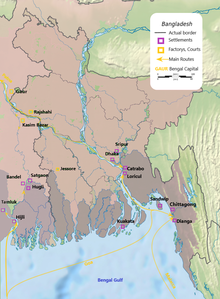
By the time Portuguese assured military help against Sher Shah, the Mughals already had started to conquer the Sultanate of Ghiyasuddin Mahmud.[80] In 1666, the Mughal government of Bengal led by viceroy Shaista Khan moved to retake Chittagong from Portuguese and Arakanese control. They launched the Mughal conquest of Chittagong. The Mughals attacked the Arakanese from the jungle with a 6,500-strong army, which was further supported by 288 Mughal naval ships blockading the Chittagong harbour. After three days of battle, the Arakanese surrendered. The Mughals expelled the Portuguese from Chittagong. Mughal rule ushered a new era in the history of Chittagong territory to the southern bank of Kashyapnadi (Kaladan river). The port city was renamed as Islamabad.
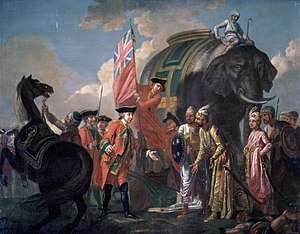
After the 1757 Battle of Plassey, Bengal was the first region of the Indian subcontinent conquered by the British East India Company. The company formed the Presidency of Fort William, which administered the region until 1858. A notable aspect of company rule was the Permanent Settlement, which established the feudal zamindari system.[81] The plunder of Bengal directly contributed to the Industrial Revolution in Britain, with the capital amassed from Bengal used to invest in British industries such as textile and greatly increase British wealth, while at the same time leading to deindustrialisation of Bengal's traditional textile industry.[82][83] The economic mismanagement directly led to the Great Bengal famine of 1770, which is estimated to have caused the deaths of about 10 million people,[84] as a third of the population in the affected region starved to death.[85] Several rebellions broke out during the early 19th century (including one led by Titumir), but British rule displaced the Muslim ruling class. A conservative Islamic cleric, Haji Shariatullah, sought to overthrow the British by propagating Islamic revivalism.[86] Several towns in Bangladesh participated in the Indian Rebellion of 1857[87] and pledged allegiance to the last Mughal emperor, Bahadur Shah Zafar, who was later exiled to neighbouring Burma.
The challenge posed to company rule by the failed Indian Mutiny led to the creation of the British Indian Empire as a crown colony. The British established several schools, colleges and a university in what is now Bangladesh. Syed Ahmed Khan and Ram Mohan Roy promoted modern and liberal education in the subcontinent, inspiring the Aligarh movement[88] and the Bengal Renaissance.[89] During the late 19th century, novelists, social reformers and feminists emerged from Muslim Bengali society. Electricity and municipal water systems were introduced in the 1890s; cinemas opened in many towns during the early 20th century. East Bengal's plantation economy was important to the British Empire, particularly its jute and tea. The British established tax-free river ports, such as the Port of Narayanganj, and large seaports like the Port of Chittagong.
Bengal had the highest gross domestic product in British India.[90] Bengal was one of the first regions in Asia to have a railway. The first railway in what is now Bangladesh began operating in 1862.[91] In comparison, Japan saw its first railway in 1872. The main railway companies in the region were the Eastern Bengal Railway and Assam Bengal Railway. Railways competed with waterborne transport to become one of the main mediums of transport.[92]

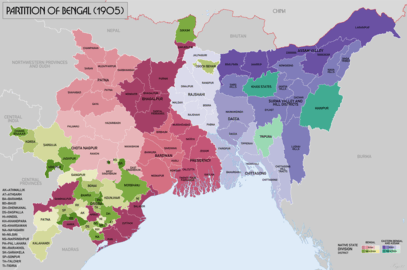
Supported by the Muslim aristocracy, the British government created the province of Eastern Bengal and Assam in 1905; the new province received increased investment in education, transport and industry.[93] However, the first partition of Bengal created an uproar in Calcutta and the Indian National Congress. In response to growing Hindu nationalism, the All India Muslim League was formed in Dhaka during the 1906 All India Muhammadan Educational Conference. The British government reorganised the provinces in 1912, reuniting East and West Bengal and making Assam a second province.

The Raj was slow to allow self-rule in the colonial subcontinent. It established the Bengal Legislative Council in 1862, and the council's native Bengali representation increased during the early 20th century. The Bengal Provincial Muslim League was formed in 1913 to advocate civil rights for Bengali Muslims within a constitutional framework. During the 1920s, the league was divided into factions supporting the Khilafat movement and favouring co-operation with the British to achieve self-rule. Segments of the Bengali elite supported Mustafa Kemal Atatürk's secularist forces.[94] In 1929, the All Bengal Tenants Association was formed in the Bengal Legislative Council to counter the influence of the Hindu landed gentry, and the Indian Independence and Pakistan Movements strengthened during the early 20th century. After the Morley-Minto Reforms and the diarchy era in the legislatures of British India, the British government promised limited provincial autonomy in 1935. The Bengal Legislative Assembly, British India's largest legislature, was established in 1937.
Although it won a majority of seats in 1937, the Bengal Congress boycotted the legislature. A. K. Fazlul Huq of the Krishak Praja Party was elected as the first Prime Minister of Bengal. In 1940 Huq supported the Lahore Resolution, which envisaged independent states in the northwestern and eastern Muslim-majority regions of the subcontinent. The first Huq ministry, a coalition with the Bengal Provincial Muslim League, lasted until 1941; it was followed by a Huq coalition with the Hindu Mahasabha which lasted until 1943. Huq was succeeded by Khawaja Nazimuddin, who grappled with the effects of the Burma Campaign, the Bengal famine of 1943, which killed up to 3 million people,[95] and the Quit India movement. In 1946, the Bengal Provincial Muslim League won the provincial election, taking 113 of the 250-seat assembly (the largest Muslim League mandate in British India). H. S. Suhrawardy, who made a final futile effort for a United Bengal in 1946, was the last premier of Bengal.
Partition of Bengal (1947)

On 3 June 1947, the Mountbatten Plan outlined the partition of British India. On 20 June, the Bengal Legislative Assembly met to decide on the partition of Bengal. At the preliminary joint meeting, it was decided (120 votes to 90) that if the province remained united it should join the Constituent Assembly of Pakistan. At a separate meeting of legislators from West Bengal, it was decided (58 votes to 21) that the province should be partitioned and West Bengal should join the Constituent Assembly of India. At another meeting of legislators from East Bengal, it was decided (106 votes to 35) that the province should not be partitioned and (107 votes to 34) that East Bengal should join the Constituent Assembly of Pakistan if Bengal was partitioned.[96] On 6 July, the Sylhet region of Assam voted in a referendum to join East Bengal. Cyril Radcliffe was tasked with drawing the borders of Pakistan and India, and the Radcliffe Line established the borders of present-day Bangladesh.
Union with Pakistan
.svg.png)
The Dominion of Pakistan was created on 14 August 1947. East Bengal, with Dhaka as its capital, was the most populous province of the 1947 Pakistani federation (led by Governor General Muhammad Ali Jinnah, who promised freedom of religion and secular democracy in the new state).[97][98] East Bengal was also Pakistan's most cosmopolitan province, home to peoples of different faiths, cultures and ethnic groups. Partition gave increased economic opportunity to East Bengalis, producing an urban population during the 1950s.[99][100]
Khawaja Nazimuddin was East Bengal's first chief minister with Frederick Chalmers Bourne its governor. The All Pakistan Awami Muslim League was formed in 1949. In 1950, the East Bengal Legislative Assembly enacted land reform, abolishing the Permanent Settlement and the zamindari system.[101] The 1952 Bengali Language Movement was the first sign of friction between the country's geographically-separated wings. The Awami Muslim League was renamed the more-secular Awami League in 1953.[102] The first constituent assembly was dissolved in 1954; this was challenged by its East Bengali speaker, Maulvi Tamizuddin Khan. The United Front coalition swept aside the Muslim League in a landslide victory in the 1954 East Bengali legislative election. The following year, East Bengal was renamed East Pakistan as part of the One Unit program and the province became a vital part of the Southeast Asia Treaty Organization.

Pakistan adopted its first constitution in 1956. Three Bengalis were its Prime Minister until 1957: Nazimuddin, Mohammad Ali of Bogra and Suhrawardy. None of the three completed their terms, and resigned from office. The Pakistan Army imposed military rule in 1958, and Ayub Khan was the country's strongman for 11 years. Political repression increased after the coup. Khan introduced a new constitution in 1962, replacing Pakistan's parliamentary system with a presidential and gubernatorial system (based on electoral college selection) known as Basic Democracy. In 1962 Dhaka became the seat of the National Assembly of Pakistan, a move seen as appeasing increased Bengali nationalism.[103] The Pakistani government built the controversial Kaptai Dam, displacing the Chakma people from their indigenous homeland in the Chittagong Hill Tracts.[104] During the 1965 presidential election, Fatima Jinnah lost to Ayub Khan despite support from the Combined Opposition alliance (which included the Awami League).[105] The Indo-Pakistani War of 1965 blocked cross-border transport links with neighbouring India in what is described as a second partition.[106] In 1966, Awami League leader Sheikh Mujibur Rahman announced a six-point movement for a federal parliamentary democracy.
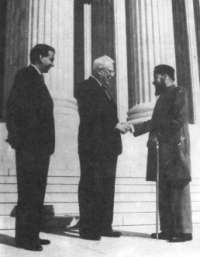
According to senior World Bank officials, Pakistan practised extensive economic discrimination against East Pakistan: greater government spending on West Pakistan, financial transfers from East to West Pakistan, the use of East Pakistan's foreign-exchange surpluses to finance West Pakistani imports, and refusal by the central government to release funds allocated to East Pakistan because the previous spending had been under budget;[107] though East Pakistan generated 70 percent of Pakistan's export revenue with its jute and tea.[108] Sheikh Mujibur Rahman was arrested for treason in the Agartala Conspiracy Case and was released during the 1969 uprising in East Pakistan which resulted in Ayub Khan's resignation. General Yahya Khan assumed power, reintroducing martial law.
Ethnic and linguistic discrimination was common in Pakistan's civil and military services, in which Bengalis were under-represented. Fifteen percent of Pakistani central-government offices were occupied by East Pakistanis, who formed 10 percent of the military.[109] Cultural discrimination also prevailed, making East Pakistan forge a distinct political identity.[110] Pakistan banned Bengali literature and music in state media, including the works of Nobel laureate Rabindranath Tagore.[111] A cyclone devastated the coast of East Pakistan in 1970, killing an estimated 500,000 people,[112] and the central government was criticised for its poor response.[113] After the December 1970 elections, calls for the independence of East Bengal became louder; the Bengali-nationalist Awami League won 167 of 169 East Pakistani seats in the National Assembly. The League claimed the right to form a government and develop a new constitution but was strongly opposed by the Pakistani military and the Pakistan Peoples Party (led by Zulfikar Ali Bhutto).
War of Independence
.jpg)
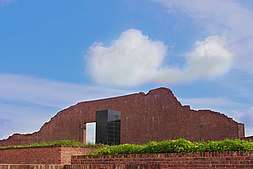
The Bengali population was angered when Prime Minister-elect Sheikh Mujibur Rahman was prevented from taking the office.[114] Civil disobedience erupted across East Pakistan, with calls for independence.[115] Mujib addressed a pro-independence rally of nearly 2 million people in Dacca (as Dhaka used to be spelled in English) on 7 March 1971, where he said, "This time the struggle is for our freedom. This time the struggle is for our independence." The flag of Bangladesh was raised for the first time on 23 March, Pakistan's Republic Day.[116] Later, on 25 March late evening, the Pakistani military junta led by Yahya Khan launched a sustained military assault on East Pakistan under the code name of Operation Searchlight.[117][118] The Pakistan Army arrested Sheikh Mujibur Rahman and flew him away to Karachi.[119][120][121] However, before his arrest Mujib proclaimed the Independence of Bangladesh at midnight on 26 March which led the Bangladesh Liberation War to break out within hours. The Pakistan Army continued to massacre Bengali students, intellectuals, politicians, civil servants and military defectors in the 1971 Bangladesh genocide, while the Mukti Bahini and other Bengali guerrilla forces created strong resistance throughout the country.[122] During the war, an estimated 0.3 to 3 million people were killed and several million people took shelter in neighbouring India.[123] Global public opinion turned against Pakistan as news of the atrocities spread;[124] the Bangladesh movement was supported by prominent political and cultural figures in the West, including Ted Kennedy, George Harrison, Bob Dylan, Joan Baez, Victoria Ocampo and André Malraux.[125][126][127] The Concert for Bangladesh was held at Madison Square Garden in New York City to raise funds for Bangladeshi refugees. The first major benefit concert in history, it was organised by Harrison and Indian Bengali sitarist Ravi Shankar.[128]
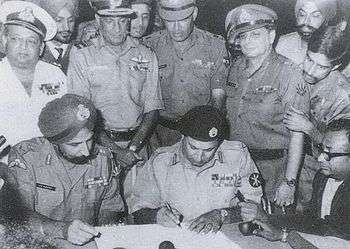
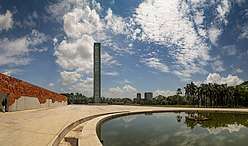
During the Bangladesh Liberation War, Bengali nationalists declared independence and formed the Mukti Bahini (the Bangladeshi National Liberation Army). The Provisional Government of Bangladesh was established on 17 April 1971, converting the 469 elected members of the Pakistani national assembly and East Pakistani provincial assembly into the Constituent Assembly of Bangladesh. The provisional government issued a proclamation that became the country's interim constitution and declared "equality, human dignity and social justice" as its fundamental principles. Due to Mujib's detention, Syed Nazrul Islam took over the role of Acting President, while Tajuddin Ahmad was named Bangladesh's first Prime Minister. The Mukti Bahini and other Bengali guerrilla forces formed the Bangladesh Forces which became the military wing of the provisional government. Led by General M. A. G. Osmani and eleven sector commanders, the forces held the countryside during the war and conducted wide-ranging guerrilla operations against Pakistani forces. As a result, almost the entire country except the capital Dacca was liberated by Bangladesh Forces by late November.
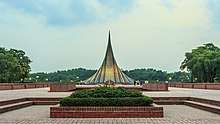
This led the Pakistan Army to attack neighbouring India's western front on 2 December 1971. India retaliated in both the western and eastern fronts. With a joint ground advance by Bangladeshi and Indian forces, coupled with air strikes by both India and the small Bangladeshi air contingent, the capital Dacca was liberated from Pakistani occupation in mid-December. During the last phase of the war, both the Soviet Union and the United States dispatched naval forces to the Bay of Bengal in a Cold War standoff. The nine-months long war ended with the surrender of Pakistani armed forces to the Bangladesh-India Allied Forces on 16 December 1971.[129][130] Under international pressure, Pakistan released Rahman from imprisonment on 8 January 1972 and he was flown by the British Royal Air Force to a million-strong homecoming in Dacca.[131][132] Remaining Indian troops were withdrawn by 12 March 1972, three months after the war ended.[133]
The cause of Bangladeshi self-determination was recognised around the world. By August 1972, the new state was recognised by 86 countries.[124] Pakistan recognised Bangladesh in 1974 after pressure from most of the Muslim countries.[134]
People's Republic of Bangladesh
First parliamentary era
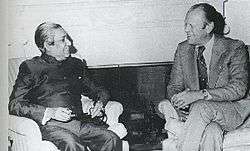
The constituent assembly adopted the constitution of Bangladesh on 4 November 1972, establishing a secular, multiparty parliamentary democracy. The new constitution included references to socialism, and Prime Minister Sheikh Mujibur Rahman nationalised major industries in 1972.[135] A major reconstruction and rehabilitation program was launched. The Awami League won the country's first general election in 1973, securing a large majority in the "Jatiyo Sangshad", the national parliament. Bangladesh joined the Commonwealth of Nations, the UN, the OIC and the Non-Aligned Movement, and Rahman strengthened ties with India. Amid growing agitation by the opposition National Awami Party and National Socialist Party, he became increasingly authoritarian. Rahman amended the constitution, giving himself more emergency powers (including the suspension of fundamental rights). The Bangladesh famine of 1974 also worsened the political situation.[136]
Presidential era and coups (1975–1991)
In January 1975, Sheikh Mujibur Rahman introduced one-party socialist rule under BAKSAL. Rahman banned all newspapers except four state-owned publications, and amended the constitution to increase his power. He was assassinated during a coup on 15 August 1975. Martial law was declared, and the presidency passed to the usurper Khondaker Mostaq Ahmad for four months. Ahmad is widely regarded as a traitor by Bangladeshis.[137] Tajuddin Ahmad, the nation's first prime minister, and four other independence leaders were assassinated on 4 November 1975. Chief Justice Abu Sadat Mohammad Sayem was installed as president by the military on 6 November 1975. Bangladesh was governed by a military junta led by the Chief Martial Law Administrator for three years. In 1977, the army chief Ziaur Rahman became president. Rahman reinstated multiparty politics, privatised industries and newspapers, established BEPZA and held the country's second general election in 1979. A semi-presidential system evolved, with the Bangladesh Nationalist Party (BNP) governing until 1982. Rahman was assassinated in 1981, and was succeeded by Vice-President Abdus Sattar. Sattar received 65.5 percent of the vote in the 1981 presidential election.[138]
After a year in office, Sattar was overthrown in the 1982 Bangladesh coup d'état. Chief Justice A. F. M. Ahsanuddin Chowdhury was installed as president, but army chief Hussain Muhammad Ershad became the country's de facto leader and assumed the presidency in 1983. Ershad lifted martial law in 1986. He governed with four successive prime ministers (Ataur Rahman Khan, Mizanur Rahman Chowdhury, Moudud Ahmed and Kazi Zafar Ahmed) and a parliament dominated by his Jatiyo Party. General elections were held in 1986 and 1988, although the latter was boycotted by the opposition BNP and Awami League. Ershad pursued administrative decentralisation, dividing the country into 64 districts, and pushed Parliament to make Islam the state religion in 1988.[139] A 1990 mass uprising forced him to resign, and Chief Justice Shahabuddin Ahmed led the country's first caretaker government as part of the transition to parliamentary rule.[138]
Current parliamentary era (1991–present)
After the 1991 general election, the twelfth amendment to the constitution restored the parliamentary republic and Begum Khaleda Zia became Bangladesh's first female prime minister. Zia, a former first lady, led a BNP government from 1990 to 1996. In 1991 her finance minister, Saifur Rahman, began a major program to liberalise the Bangladeshi economy.[136]
In February 1996, a general election was held which was boycotted by all opposition parties giving a 300 (of 300) seat victory for BNP. This election was deemed illegitimate, so a system of a caretaker government was introduced to oversee the transfer of power and a new election was held in June 1996, overseen by Justice Muhammad Habibur Rahman, the first Chief Adviser of Bangladesh. The Awami League won the seventh general election, marking its leader Sheikh Hasina's first term as Prime Minister. Hasina's first term was highlighted by the Chittagong Hill Tracts Peace Accord and a Ganges water-sharing treaty with India. The second caretaker government, led by Chief Adviser Justice Latifur Rahman, oversaw the 2001 Bangladeshi general election which returned Begum Zia and the BNP to power.
The second Zia administration saw improved economic growth, but political turmoil gripped the country between 2004 and 2006. A radical Islamist militant group, the JMB, carried out a series of terror attacks. The evidence of staging these attacks by these extremist groups have been found in the investigation, and hundreds of suspected members were detained in numerous security operations in 2006, including the two chiefs of the JMB, Shaykh Abdur Rahman and Bangla Bhai, who were executed with other top leaders in March 2007, bringing the militant group to an end.[142]
In 2006, at the end of the term of the BNP administration, there was widespread political unrest related to the handover of power to a caretaker government. As such, the Bangladeshi military urged President Iajuddin Ahmed to impose a state of emergency and a caretaker government, led by technocrat Fakhruddin Ahmed, was installed.[136] Emergency rule lasted for two years, during which time investigations into members of both Awami League and BNP were conducted, including their leaders Sheikh Hasina and Khaleda Zia.[143][144] In 2008 the ninth general election saw a return to power for Sheikh Hasina and the Awami League led Grand Alliance in a landslide victory. In 2010, the Supreme Court ruled martial law illegal and affirmed secular principles in the constitution. The following year, the Awami League abolished the caretaker-government system.
Citing the lack of caretaker government the 2014 general election was boycotted by the BNP and other opposition parties, giving the Awami League a decisive victory. The election was controversial with reports of violence and an alleged crackdown on the opposition in the run-up to the election and 153 seats (of 300) went uncontested in the election. Despite the controversy Hasina went on to form a government which saw her return for a third term as Prime Minister. Due to strong domestic demand, Bangladesh emerged as one of the fastest-growing economies in the world.[145] However, human rights abuses increased under the Hasina administration, particularly enforced disappearances. Between 2016 and 2017, an estimated 1 million Rohingya refugees took shelter in southeastern Bangladesh amid a military crackdown in neighbouring Rakhine State, Myanmar.
In 2018, the country saw major movements for government quota reforms and road-safety. The 2018 Bangladeshi general election was marred by allegations of widespread vote rigging.[146] The Awami League won 259 out of 300 seats and the main opposition alliance Jatiya Oikya Front secured only 8 seats, with Sheikh Hasina becoming the longest-serving prime minister in Bangladeshi history.[147] Pro-democracy leader Dr. Kamal Hossain called for an annulment of the election result and for a new election to be held in a free and fair manner.[148] The election was also observed by European Union observers.[149]
Geography

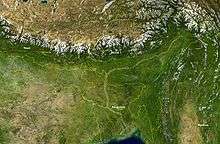
The geography of Bangladesh is divided between three regions. Most of the country is dominated by the fertile Ganges-Brahmaputra delta, which is the largest river delta in the world.[150][151][152] The northwest and central parts of the country are formed by the Madhupur and the Barind plateaus. The northeast and southeast are home to evergreen hill ranges.
The Ganges delta is formed by the confluence of the Ganges (local name Padma or Pôdda), Brahmaputra (Jamuna or Jomuna), and Meghna rivers and their respective tributaries. The Ganges unites with the Jamuna (main channel of the Brahmaputra) and later joins the Meghna, finally flowing into the Bay of Bengal. Bangladesh has 57 trans-boundary rivers, making the resolution of water issues politically complicated, in most cases, as the country is a lower riparian state to India.[153]
Bangladesh is predominantly rich fertile flat land. Most of it is less than 12 m (39 ft) above sea level, and it is estimated that about 10% of its land would be flooded if the sea level were to rise by 1 m (3.3 ft).[154] 17% of the country is covered by forests and 12% is covered by hill systems. The country's haor wetlands are of significance to global environmental science.
In southeastern Bangladesh, experiments have been done since the 1960s to 'build with nature'. Construction of cross dams has induced a natural accretion of silt, creating new land. With Dutch funding, the Bangladeshi government began promoting the development of this new land in the late 1970s. The effort has become a multi-agency endeavour, building roads, culverts, embankments, cyclone shelters, toilets and ponds, as well as distributing land to settlers.[155] Years of collaboration with donors and global experts in water resources management has enabled Bangladesh to formulate strategies to combat the impacts of climate change. In Sep 2018, Bangladesh Government approved Bangladesh Delta Plan 2100, a combination of long-term strategies and subsequent interventions for ensuring long term water and food security, economic growth and environmental sustainability.[156] The formulation of the plan was led by the General Economics Division of the Ministry of Planning, and supported by the Embassy of the Kingdom of the Netherlands, bringing together cross-sectoral expertise from the Netherlands and Bangladesh.[157]
With an elevation of 1,064 m (3,491 ft), Saka Haphong (also known as Mowdok Mual) near the border with Myanmar, is claimed to be the highest peak of Bangladesh.[158] However, it is not yet widely recognized as the highest point of the country, and most sources give the honor to Keokradong.[159]
Administrative geography
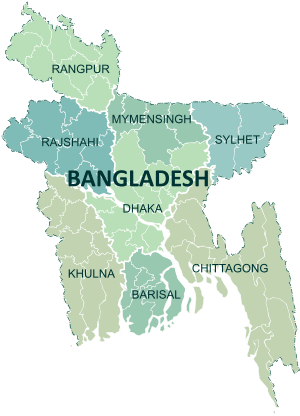

Bangladesh is divided into eight administrative divisions,[160][161][162] each named after their respective divisional headquarters: Barisal (officially Barishal[163]), Chittagong (officially Chattogram[163]), Dhaka, Khulna, Mymensingh, Rajshahi, Rangpur, and Sylhet.
Divisions are subdivided into districts (zila). There are 64 districts in Bangladesh, each further subdivided into upazila (subdistricts) or thana. The area within each police station, except for those in metropolitan areas, is divided into several unions, with each union consisting of multiple villages. In the metropolitan areas, police stations are divided into wards, which are further divided into mahallas.
There are no elected officials at the divisional or district levels, and the administration is composed only of government officials. Direct elections are held in each union (or ward) for a chairperson and a number of members. In 1997, a parliamentary act was passed to reserve three seats (out of 12) in every union for female candidates.[164]
| Division | Capital | Established | Area (km2)[165] | 2016 Population[165] | Density[165] |
|---|---|---|---|---|---|
| Barisal Division | Barisal | 1 January 1993 | 13,225 | 9,145,000 | 691 |
| Chittagong Division | Chittagong | 1 January 1829 | 33,909 | 31,980,000 | 943 |
| Dhaka Division | Dhaka | 1 January 1829 | 20,594 | 40,171,000 | 1,951 |
| Khulna Division | Khulna | 1 October 1960 | 22,284 | 17,252,000 | 774 |
| Mymensingh Division | Mymensingh | 14 September 2015 | 10,584 | 12,368,000 | 1,169 |
| Rajshahi Division | Rajshahi | 1 January 1829 | 18,153 | 20,412,000 | 1,124 |
| Rangpur Division | Rangpur | 25 January 2010 | 16,185 | 17,602,000 | 1,088 |
| Sylhet Division | Sylhet | 1 August 1995 | 12,635 | 11,291,000 | 894 |
Climate
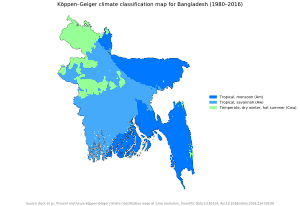
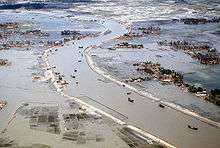
Straddling the Tropic of Cancer, Bangladesh's climate is tropical with a mild winter from October to March, and a hot, humid summer from March to June. The country has never recorded an air temperature below 0 °C (32 °F), with a record low of 1.1 °C (34.0 °F) in the north west city of Dinajpur on 3 February 1905.[167] A warm and humid monsoon season lasts from June to October and supplies most of the country's rainfall.
Natural calamities, such as floods, tropical cyclones, tornadoes, and tidal bores occur almost every year,[168] combined with the effects of deforestation, soil degradation and erosion. The cyclones of 1970 and 1991 were particularly devastating, the latter killing some 140,000 people.[169]
In September 1998, Bangladesh saw the most severe flooding in modern world history. As the Brahmaputra, the Ganges and Meghna spilt over and swallowed 300,000 houses, 9,700 km (6,000 mi) of road and 2,700 km (1,700 mi) of embankment, 1,000 people were killed and 30 million more were made homeless; 135,000 cattle were killed; 50 km2 (19 sq mi) of land were destroyed; and 11,000 km (6,800 mi) of roads were damaged or destroyed. Effectively, two-thirds of the country was underwater. The severity of the flooding was attributed to unusually high monsoon rains, the shedding of equally unusually large amounts of melt water from the Himalayas, and the widespread cutting down of trees (that would have intercepted rain water) for firewood or animal husbandry.[170] As a result of various international and national level initiatives in disaster risk reduction, human toll and economic damage from floods and cyclones have come down over the years.[171] A similar country wide flood in 2007, which left five million people displaced, had a death toll around 500,[172]
Bangladesh is now widely recognised to be one of the countries most vulnerable to climate change.[173][174] Over the course of a century, 508 cyclones have affected the Bay of Bengal region, 17 percent of which are believed to have caused landfall in Bangladesh.[175] Natural hazards that come from increased rainfall, rising sea levels, and tropical cyclones are expected to increase as the climate changes, each seriously affecting agriculture, water and food security, human health, and shelter.[176] It is estimated that by 2050, a 3 feet rise in sea levels will inundate some 20 percent of the land and displace more than 30 million people.[177] To address the sea level rise threat in Bangladesh, the Bangladesh Delta Plan 2100 has been launched.[178][179]
There is evidence that earthquakes pose a threat to the country and that plate tectonics have caused rivers to shift course suddenly and dramatically. It has been shown that rainy-season flooding in Bangladesh, on the world's largest river delta, can push the underlying crust down by as much as 6 centimetres, and possibly perturb faults.[180]
Bangladeshi water is frequently contaminated with arsenic because of the high arsenic content of the soil—up to 77 million people are exposed to toxic arsenic from drinking water.[181][182]
Biodiversity
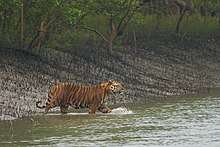
Bangladesh ratified the Rio Convention on Biological Diversity on 3 May 1994.[183] As of 2014, the country was set to revise its National Biodiversity Strategy and Action Plan.[183]
Bangladesh is located in the Indomalayan realm. Its ecology includes a long sea coastline, numerous rivers and tributaries, lakes, wetlands, evergreen forests, semi evergreen forests, hill forests, moist deciduous forests, freshwater swamp forests and flat land with tall grass. The Bangladesh Plain is famous for its fertile alluvial soil which supports extensive cultivation. The country is dominated by lush vegetation, with villages often buried in groves of mango, jackfruit, bamboo, betel nut, coconut and date palm.[184] The country has up to 6000 species of plant life, including 5000 flowering plants.[185] Water bodies and wetland systems provide a habitat for many aquatic plants. Water lilies and lotuses grow vividly during the monsoon season. The country has 50 wildlife sanctuaries.
Bangladesh is home to much of the Sundarbans, the world's largest mangrove forest, covering an area of 6,000 km2 in the southwest littoral region. It is divided into three protected sanctuaries–the South, East and West zones. The forest is a UNESCO World Heritage Site. The northeastern Sylhet region is home to haor wetlands, which is a unique ecosystem. It also includes tropical and subtropical coniferous forests, a freshwater swamp forest and mixed deciduous forests. The southeastern Chittagong region covers evergreen and semi evergreen hilly jungles. Central Bangladesh includes the plainland Sal forest running along the districts of Gazipur, Tangail and Mymensingh. St. Martin's Island is the only coral reef in the country.
Bangladesh has an abundance of wildlife in its forests, marshes, woodlands and hills.[184] The vast majority of animals dwell within a habitat of 150,000 km2.[186] The Bengal tiger, clouded leopard, saltwater crocodile, black panther and fishing cat are among the chief predators in the Sundarbans.[187] Northern and eastern Bangladesh is home to the Asian elephant, hoolock gibbon, Asian black bear and oriental pied hornbill.[188]
The Chital deer are widely seen in southwestern woodlands. Other animals include the black giant squirrel, capped langur, Bengal fox, sambar deer, jungle cat, king cobra, wild boar, mongooses, pangolins, pythons and water monitors. Bangladesh has one of the largest population of Irrawaddy dolphins and Ganges dolphins. A 2009 census found 6,000 Irrawaddy dolphins inhabiting the littoral rivers of Bangladesh.[189] The country has numerous species of amphibians (53), reptiles (139), marine reptiles (19) and marine mammals (5). It also has 628 species of birds.[190]
Several animals became extinct in Bangladesh during the last century, including the one horned and two horned rhinoceros and common peafowl. The human population is concentrated in urban areas, hence limiting deforestation to a certain extent. Rapid urban growth has threatened natural habitats. Although many areas are protected under law, a large portion of Bangladeshi wildlife is threatened by this growth. Furthermore, access to biocapacity in Bangladesh is low. In 2016, Bangladesh had 0.4 global hectares[191] of biocapacity per person within its territory, or about one fourth of the world average. In contrast, in 2016, they used 0.84 global hectares of biocapacity – their ecological footprint of consumption. As a result, Bangladesh is running a biocapacity deficit.[191]
The Bangladesh Environment Conservation Act was enacted in 1995. The government has designated several regions as Ecologically Critical Areas, including wetlands, forests and rivers. The Sundarbans tiger project and the Bangladesh Bear Project are among the key initiatives to strengthen conservation.[188]
Politics and government
.jpg)
Bangladesh is a de jure representative democracy under its constitution, with a Westminster-style unitary parliamentary republic that has universal suffrage. The head of government is the Prime Minister, who is invited to form a government every five years by the President. The President invites the leader of the largest party in parliament to become Prime Minister of the world's fifth largest democracy.[192] Bangladesh experienced a two party system between 1990 and 2014, when the Awami League and the Bangladesh Nationalist Party (BNP) alternated in power. During this period, elections were managed by a neutral caretaker government. But the caretaker government was abolished by the Awami League government in 2011. The BNP boycotted the next election in 2014, arguing that it would not be fair without a caretaker government. The BNP-led Jatiya Oikya Front participated in the 2018 election and lost. The election saw many allegations of irregularities. Bangladesh has a prominent civil society since the colonial period. There are various special interest groups, including non-governmental organisations, human rights organisations, professional associations, chambers of commerce, employers' associations and trade unions.[193]
One of the key aspects of Bangladeshi politics is the "spirit of the liberation war" which refers to the ideals of the liberation movement during the Bangladesh Liberation War.[194] The Proclamation of Independence enunciated the values of "equality, human dignity and social justice". In 1972, the constitution included a bill of rights and declared "nationalism, socialism, democracy and secularity" as the principles of government policy. Socialism was later de-emphasised and neglected by successive governments. Bangladesh has a market-based economy. To many Bangladeshis, especially in the younger generation, the spirit of the liberation war is a vision for a society based on civil liberties, human rights, the rule of law and good governance.[195]
Executive branch
The Government of Bangladesh is overseen by a cabinet headed by the Prime Minister of Bangladesh. The tenure of a parliamentary government is five years. The Bangladesh Civil Service assists the cabinet in running the government. Recruitment for the civil service is based on a public examination. In theory, the civil service should be a meritocracy. But a disputed quota system coupled with politicisation and preference for seniority have allegedly affected the civil service's meritocracy.[196] The President of Bangladesh is the ceremonial head of state[197] whose powers include signing bills passed by parliament into law. The President is elected by the parliament and has a five-year term. Under the constitution, the president acts on the advice of the prime minister. The President is the Supreme Commander of the Bangladesh Armed Forces and the chancellor of all universities.
Legislative branch
The Jatiya Sangshad (National Assembly) is the unicameral parliament. It has 350 Members of Parliament (MPs), including 300 MPs elected on the first past the post system and 50 MPs appointed to reserved seats for women's empowerment. Article 70 of the Constitution of Bangladesh forbids MPs from voting against their party. However, several laws proposed independently by MPs have been transformed into legislation, including the anti-torture law.[198] The parliament is presided over by the Speaker of the Jatiya Sangsad, who is second in line to the president as per the constitution. There is also a Deputy Speaker. When a president is incapable of performing duties (i.e. due to illness), the Speaker steps in as Acting President and the Deputy Speaker becomes Acting Speaker. A recurring proposal suggests that the Deputy Speaker should be a member of the opposition.[199]
Legal system
The Supreme Court of Bangladesh is the highest court of the land followed by the High Court and Appellate Divisions. The head of the judiciary is the Chief Justice of Bangladesh, who sits on the Supreme Court. The courts have wide latitude in judicial review and judicial precedent is supported by the Article 111 of the constitution. The judiciary includes district and metropolitan courts, which are divided into civil and criminal courts. Due to a shortage of judges, the judiciary has a large backlog. The Bangladesh Judicial Service Commission is an independent body responsible for judicial appointments, salaries and discipline.
Bangladesh's legal system is based on common law and its principal source of laws are acts of Parliament.[200] The Bangladesh Code includes a list of all laws in force in the country. The code begins in 1836 and most of its listed laws were crafted under the British Raj by the Bengal Legislative Council, the Bengal Legislative Assembly, the Eastern Bengal and Assam Legislative Council, the Imperial Legislative Council and the Parliament of the United Kingdom. One example is the 1860 Penal Code. From 1947 to 1971, laws were enacted by Pakistan's national assembly and the East Pakistani legislature. The Constituent Assembly of Bangladesh was the country's provisional parliament until 1973, when the first elected Jatiyo Sangshad (National Parliament) was sworn in. Although most of Bangladesh's laws were compiled in English, after a 1987 government directive laws are now primarily written in Bengali. While most of Bangladeshi law is secular; marriage, divorce and inheritance are governed by Islamic, Hindu and Christian family law. The judiciary is often influenced by legal developments in the Commonwealth of Nations, such as the doctrine of legitimate expectation.
Military

The Bangladesh Armed Forces have inherited the institutional framework of the British military and the British Indian Army.[201] It was formed in 1971 from the military regiments of East Pakistan. In 2018 the active personnel strength of the Bangladesh Army was around 157,500,[202] excluding the Air Force and the Navy (24,000).[203] In addition to traditional defence roles, the military has supported civil authorities in disaster relief and provided internal security during periods of political unrest. For many years, Bangladesh has been the world's largest contributor to UN peacekeeping forces. In February 2015, the country made major deployments to Côte d'Ivoire, Cyprus, Darfur, the Democratic Republic of Congo, the Golan Heights, Haiti, Lebanon, Liberia and South Sudan.[204]
The Bangladesh Navy has the third-largest fleet of countries dependent on the Bay of Bengal, including guided-missile frigates, submarines, cutters and aircraft. The Bangladesh Air Force is equipped with several Russian multi-role fighter jets. Bangladesh cooperates defensively with the United States Armed Forces, participating in the Cooperation Afloat Readiness and Training (CARAT) exercises. Ties between the Bangladeshi and the Indian military exist with high-level visits by the military chiefs of both countries.[205][206] Most of Bangladesh's military equipment comes from China.[207] In 2019, Bangladesh ratified the UN Treaty on the Prohibition of Nuclear Weapons.[208]
Foreign relations
The first major intergovernmental organisation joined by Bangladesh was the Commonwealth of Nations in 1972. The country joined the United Nations in 1974, and has been elected twice to the UN Security Council. Ambassador Humayun Rashid Choudhury was elected president of the UN General Assembly in 1986. Bangladesh relies on multilateral diplomacy in the World Trade Organization. It is a major contributor to UN peacekeeping, providing 113,000 personnel to 54 UN missions in the Middle East, the Balkans, Africa and the Caribbean in 2014.[209]
In addition to membership in the Commonwealth of Nations and the United Nations, Bangladesh pioneered regional co-operation in South Asia. Bangladesh is a founding member of the South Asian Association for Regional Cooperation (SAARC), an organisation designed to strengthen relations and promote economic and cultural growth among its members. It has hosted several summits and two Bangladeshi diplomats were the organisation's secretary-general.
Bangladesh joined the Organization of Islamic Cooperation (OIC) in 1973. It has hosted the summit of OIC foreign ministers, which addresses issues, conflicts and disputes affecting Muslim-majority countries. Bangladesh is a founding member of the Developing 8 Countries, which is a bloc of eight Muslim-majority republics.
The neighbouring country of Myanmar (Burma) was one of the first countries to recognise Bangladesh.[210] Despite common regional interests, Bangladesh-Myanmar relations have been strained by the Rohingya refugee crisis and the isolationist policies of the Myanmar military. In 2012, both countries came to terms at the International Tribunal for the Law of the Sea over maritime boundaries in the Bay of Bengal.[211] In 2016 and 2017, relations with Myanmar were strained once again as over 700,000 Rohingya refugees illegally entered Bangladesh fleeing persecution, ethnic cleansing, genocide and other atrocities in Myanmar. The parliament, government and civil society of Bangladesh have been at the forefront of international criticism against Myanmar for military operations against the Rohingya, which the United Nations has described as ethnic cleansing.[212][213]
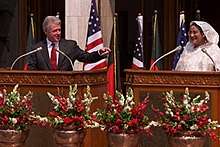
Bangladesh's most politically-important bilateral relationship is with neighbouring India. In 2015, major Indian newspapers called Bangladesh a "trusted friend".[214] Bangladesh and India are South Asia's largest trading partners. The countries are collaborating in regional economic and infrastructure projects, such as a regional motor-vehicle agreement in eastern South Asia and a coastal shipping agreement in the Bay of Bengal. Indo-Bangladesh relations often emphasise a shared cultural heritage, democratic values and a history of support for Bangladeshi independence. Despite political goodwill, border killings of Bangladeshi civilians and the lack of a comprehensive water-sharing agreement for 54 trans-boundary rivers are major issues. In 2017, India joined Russia and China in refusing to condemn Myanmar's atrocities against the Rohingya, which contradicted with Bangladesh's demand for recognising Rohingya human rights.[215] However, the Indian air force delivered aid shipments for Rohingya refugees in Bangladesh.[216] The crackdown against cattle smuggling in India has also affected Bangladesh. The Bangladeshi beef and leather industries have seen increased prices due to the Indian BJP government's Hindu nationalist campaign against the export of beef and cattle skin.[217]
Pakistan and Bangladesh have a US$550 million trade relationship,[218] particularly in Pakistani cotton imports for the Bangladeshi textile industry. Although Bangladeshi and Pakistani businesses have invested in each other, diplomatic relations are strained because of Pakistani denial of the 1971 Bangladesh genocide. The execution of a Jamaat-e-Islami leader in 2013 on committing of war crimes during the liberation war was opposed in Pakistan and led to further strained ties.[219]
Sino-Bangladesh relations date to the 1950s and are relatively warm, despite the Chinese leadership siding with Pakistan during Bangladesh's war of independence. China and Bangladesh established bilateral relations in 1976 which have significantly strengthened and the country is considered a cost-effective source of arms for the Bangladeshi military.[220] Since the 1980s 80 percent of Bangladesh's military equipment has been supplied by China (often with generous credit terms), and China is Bangladesh's largest trading partner. Both countries are part of the BCIM Forum.
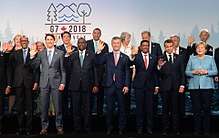
Japan is Bangladesh's largest economic-aid provider in the form of loans and the countries have common political goals.[221][222] The United Kingdom has longstanding economic, cultural and military links with Bangladesh. The United States is a major economic and security partner, its largest export market and foreign investor. Seventy-six percent of Bangladeshis viewed the United States favourably in 2014, one of the highest ratings among Asian countries.[223][224] The United States views Bangladesh as a key partner in the Indo-Pacific.[225] The European Union is Bangladesh's largest regional market, conducting public diplomacy and providing development assistance.
Relations with other countries are generally positive. Shared democratic values ease relations with Western countries and similar economic concerns forge ties to other developing countries. Despite poor working conditions and war affecting overseas Bangladeshi workers, relations with Middle Eastern countries are friendly and bounded by religion and culture. More than a million Bangladeshis are employed in the region. In 2016, the king of Saudi Arabia called Bangladesh "one of the most important Muslim countries".[226] However, Bangladesh has not established diplomatic relationship with Israel[227] in support of a sovereign Palestinian state and "an end to Israel's illegal occupation of Palestine".[228]
Bangladeshi aid agencies work in many developing countries. An example is BRAC in Afghanistan, which benefits 12 million people in that country.[229] Bangladesh has a record of nuclear nonproliferation as a party to the Nuclear Nonproliferation Treaty (NPT) and the Comprehensive Test Ban Treaty (CTBT),[230] and is also a member of Non-Aligned Movement since 1973. It is a state party to the Rome Statute of the International Criminal Court. Bangladeshi foreign policy is influenced by the principle of "friendship to all and malice to none", first articulated by Bengali statesman H. S. Suhrawardy in 1957.[221][231] Suhrawardy led East and West Pakistan to join the Southeast Asia Treaty Organization, CENTO and the Regional Cooperation for Development.
Human rights
.jpg)
A list of fundamental rights is enshrined in the country's constitution. The drafter of the constitution in 1972, Dr. Kamal Hossain, was influenced by the Universal Declaration of Human Rights.[232] Bangladesh also recognises the third gender.[233] However, Homosexuality is outlawed by section 377 of the criminal code (a legacy of the colonial period), and is punishable by a maximum of life imprisonment.[234][235] Judicial activism has often upheld human rights. In the 1970s, judges invalidated detentions under the Special Powers Act, 1974 through cases such as Aruna Sen v. Government of Bangladesh and Abdul Latif Mirza v. Government of Bangladesh. In 2008, the Supreme Court paved the way for citizenship for the Stranded Pakistanis, who were an estimated 300,000 stateless people.[236] Despite being a non-signatory of the UN Refugee Convention, Bangladesh has taken in Rohingya refugees since 1978 and the country is now home to a million refugees. Bangladesh is an active member of the International Labour Organization (ILO) since 1972. It has ratified 33 ILO conventions, including the seven fundamental ILO conventions.[237] Bangladesh has ratified the International Covenant on Civil and Political Rights and the International Covenant on Economic, Social and Cultural Rights.[238][239] In 2018, Bangladesh came under heavy criticism for its repressive Digital Security Act which threatened freedom of speech. The photojournalist Shahidul Alam was jailed and tortured for criticising the government.[240] Alam was featured in the 2018 Time Person of the Year issue.
The National Human Rights Commission of Bangladesh was set up in 2007. Notable human rights organisations and initiatives include the Centre for Law and Mediation, Odhikar, the Alliance for Bangladesh Worker Safety, the Bangladesh Environmental Lawyers Association, the Bangladesh Hindu Buddhist Christian Unity Council and the War Crimes Fact Finding Committee.
Successive governments and their security forces have flouted constitutional principles and have been accused of human rights abuses. Bangladesh is ranked "partly free" in Freedom House's Freedom in the World report,[241] but its press is ranked "not free".[242] According to the British Economist Intelligence Unit, the country has a hybrid regime: the third of four rankings in its Democracy Index.[243] Bangladesh was the third-most-peaceful South Asian country in the 2015 Global Peace Index.[244] Civil society and media in Bangladesh have been attacked by the ruling Awami League government and Islamic extremists.[245]
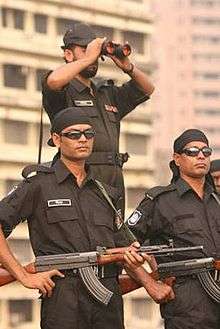
According to National Human Rights Commission, 70% of alleged human-rights violations are committed by law-enforcement agencies.[246] Targets have included Nobel Peace Prize winner Muhammad Yunus and the Grameen Bank, secularist bloggers and independent and pro-opposition newspapers and television networks. The United Nations is concerned about government "measures that restrict freedom of expression and democratic space".[245]
Bangladeshi security forces, particularly the Rapid Action Battalion (RAB), have received international condemnation for human-rights abuses (including enforced disappearances, torture and extrajudicial killings). Over 1,000 people have been said to have been victims of extrajudicial killings by RAB since its inception under the last Bangladesh Nationalist Party government.[247] The RAB has been called a "death squad" by Human Rights Watch and Amnesty International,[248][249] which have called for the force to be disbanded.[248][249] The British and American governments have been criticised for funding and engaging the force in counter-terrorism operations.[250]
The Bangladeshi government has not fully implemented the Chittagong Hill Tracts Peace Accord.[251] The Hill Tracts region remains heavily militarized, despite a peace treaty with indigenous people forged by the United People's Party of the Chittagong Hill Tracts.[252]
Secularism is protected by the constitution of Bangladesh and religious parties are barred from contesting elections; however, the government is accused of courting religious extremist groups. Islam's ambiguous position as the de facto state religion has been criticised by the United Nations.[253] Despite relative harmony, religious minorities have faced occasional persecution. The Hindu and Buddhist communities have experienced religious violence from Islamic groups – notably the Bangladesh Jamaat-e-Islami and its student wing (Shibir). However, Islamic groups are losing popular support -Islamic far-right candidates peaked at 12 percent of the vote in 2001, falling to four percent in 2008.[254]
According to the 2016 Global Slavery Index, an estimated 1,531,300 people are enslaved in modern-day Bangladesh, or 0.95% of the population.[255] A number of slaves in Bangladesh are forced to work in the fish and shrimp industries.[256][257][258]
Corruption
Like for many developing countries, institutional corruption is a serious concern for Bangladesh. Bangladesh was ranked 146th among 180 countries on Transparency International's 2018 Corruption Perceptions Index.[259] According to survey conducted by the Bangladesh chapter of TI, In 2015 bribes made up 3.7 percent of the national budget.[260] Land administration was the sector with the most bribery in 2015,[261] followed by education,[262] police[263] and water supply.[264] The Anti Corruption Commission was formed in 2004, and it was active during the 2006–08 Bangladeshi political crisis, indicting many leading politicians, bureaucrats and businessmen for graft.[265][266][267]
Economy
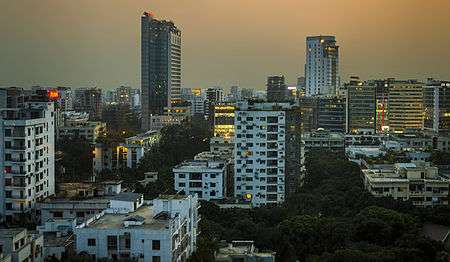
Bangladesh has the world's 39th largest economy in terms of market exchange rates and 29th largest in terms of purchasing power parity, which ranks second in South Asia after India.[268] Bangladesh is also one of the world's fastest-growing economies and one of the fastest growing middle-income countries.[269] The country has a market-based mixed economy. A developing nation, Bangladesh is one of the Next Eleven emerging markets. According to the IMF, its per-capita income was US$1,906 in 2019, with a GDP of $317 billion.[270] Bangladesh has the second-highest foreign-exchange reserves in South Asia (after India). The Bangladeshi diaspora contributed $15.31 billion in remittances in 2015.[271] Bangladesh's largest trading partners are the European Union, the United States, Japan, India, Australia, China and ASEAN. Expat workers in the Middle East and Southeast Asia send back a large chunk of remittances. The economy is driven by strong domestic demand.[269]
During its first five years of independence Bangladesh adopted socialist policies. The subsequent military regime and BNP and Jatiya Party governments restored free markets and promoted the country's private sector. In 1991, finance minister Saifur Rahman introduced a programme of economic liberalisation. The Bangladeshi private sector has rapidly expanded, with a number of conglomerates driving the economy. Major industries include textiles, pharmaceuticals, shipbuilding, steel, electronics, energy, construction materials, chemicals, ceramics, food processing and leather goods. Export-oriented industrialisation has increased with fiscal year 2018–19 exports increasing by 10.1% over the previous year to $40 billion.[272] Most export earnings are from the garment-manufacturing industry.
| Share of world GDP (PPP)[273] | |
|---|---|
| Year | Share |
| 1980 | 0.31% |
| 1990 | 0.33% |
| 2000 | 0.36% |
| 2010 | 0.44% |
| 2019 | 0.58% |
.jpg)
However, an insufficient power supply is a significant obstacle to Bangladesh's economic development. According to the World Bank, poor governance, corruption and weak public institutions are also major challenges.[274] In April 2010, Standard & Poor's gave Bangladesh a BB- long-term credit rating, below India's but above those of Pakistan and Sri Lanka.[275]
Agriculture is the largest sector of the economy, making up 14.2 percent of Bangladesh's GDP in 2017 and employing about 42.7 percent of the workforce.[276] The agricultural sector impacts employment generation, poverty alleviation, human resources development and food security. More Bangladeshis earn their living from agriculture than from any other sector. The country is among the top producers of rice (fourth), potatoes (seventh), tropical fruits (sixth), jute (second), and farmed fish (fifth).[277][278] Bangladesh is the seventh-largest natural gas producer in Asia, ahead of neighbouring Myanmar, and 56 percent of the country's electricity is generated by natural gas. Major gas fields are located in the northeastern (particularly Sylhet) and southern (including Barisal and Chittagong) regions. Petrobangla is the national energy company. The American multinational corporation Chevron produces 50 percent of Bangladesh's natural gas.[279] According to geologists, the Bay of Bengal contains large, untapped gas reserves in Bangladesh's exclusive economic zone.[280] Bangladesh has substantial coal reserves, with several coal mines operating in the northwest. Jute exports remain significant, although the global jute trade has shrunk considerably since its World War II peak. Bangladesh has one of the world's oldest tea industries, and is a major exporter of fish and seafood.
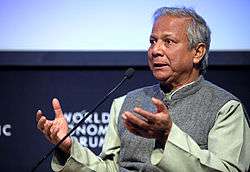
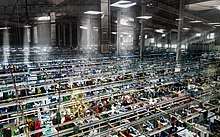
Bangladesh's textile and ready-made garment industries are the country's largest manufacturing sector, with 2017 exports of $34.1 billion.[272] Leather-goods manufacturing, particularly footwear, is the second-largest export sector. The pharmaceutical industry meets 97 percent of domestic demand, and exports to many countries.[281][282] Shipbuilding has grown rapidly, with exports to Europe.[283]
Steel is concentrated in the port city of Chittagong, and the ceramics industry is prominent in international trade. In 2005 Bangladesh was the world's 20th-largest cement producer, an industry dependent on limestone imports from northeast India. Food processing is a major sector, with local brands such as PRAN increasing their international presence. The electronics industry is growing rapidly with contributions from companies like the Walton Group.[284] Bangladesh's defense industry includes the Bangladesh Ordnance Factories and the Khulna Shipyard.
The service sector accounts for 51 percent of the country's GDP. Bangladesh ranks with Pakistan as South Asia's second-largest banking sector.[285] The Dhaka and Chittagong Stock Exchanges are the country's twin financial markets. Bangladesh's telecommunications industry is one of the world's fastest-growing, with 114 million cellphone subscribers in December 2013,[286] and Grameenphone, Banglalink, Robi and BTTB are major companies. Tourism is developing, with the beach resort of Cox's Bazar at the center of the industry. The Sylhet region, home to Bangladesh's tea gardens, also hosts a large number of visitors. The country has three UNESCO World Heritage Sites (the Mosque City, the Buddhist Vihara and the Sundarbans) and five tentative-list sites.[287]
Following the pioneering work of Akhter Hameed Khan on rural development at Bangladesh Academy for Rural Development, several NGOs in Bangladesh including BRAC (the world's largest NGO),[288] and Grameen Bank, focused on rural development and poverty alleviation in the country. Muhammad Yunus successfully pioneered microfinance as a sustainable tool for poverty alleviation and others followed suit. As of 2015, the country had over 35 million microcredit borrowers.[289] In recognition of their tangible contribution to poverty alleviation, Muhammad Yunus and Grameen Bank were jointly awarded the Nobel Peace Prize in 2006.[290]
Transport
.jpg)
Transport is a major sector of the economy. Aviation has grown rapidly, and is dominated by the flag carrier Biman Bangladesh Airlines and other privately owned airlines. Bangladesh has a number of airports including three international and several domestic STOL (short takeoff and landing) airports. The busiest, Shahjalal International Airport connects Dhaka with major destinations.
Bangladesh has a 2,706-kilometre (1,681-mile) long rail network operated by the state-owned Bangladesh Railway. The total length of the country's road and highway network is nearly 21,000 kilometers (13,000 miles).
With 8,046 kilometres (5,000 miles) of navigable waters, Bangladesh has one of the largest inland waterway networks in the world.[291] The southeastern port of Chittagong is its busiest seaport, handling over $60 billion in annual trade (more than 80 percent of the country's export-import commerce).[292] The second-busiest seaport is Mongla. Bangladesh has three seaports and 22 river ports.[293]
|
Rank | Port | Type | TEU traffic |
| |
|---|---|---|---|---|---|---|
| 1 | Port of Chittagong | Seaport | 2.3 million | |||
| 2 | Port of Pangaon | River port | 116,000 | |||
| 3 | Port of Mongla | Seaport | 70,000 | |||
| 4 | Port of Dhaka | River port | ||||
| 5 | Port of Narayanganj | River port | ||||
| 6 | Port of Ashuganj | River port | ||||
| 7 | Port of Payra | Seaport | ||||
| 8 | Aricha Ghat | River port | ||||
| 9 | Goalondo | River port | ||||
Energy and infrastructure
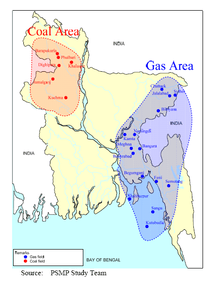
Bangladesh had an installed electrical capacity of 20,000 megawatts in 2018.[294] About 56 percent of the country's commercial energy is generated by natural gas, followed by oil, hydropower and coal. Bangladesh has planned to import hydropower from Bhutan and Nepal.[295] A nuclear power plant is under construction with Russian support in the Ruppur Nuclear Power Plant project.[296] The country ranks fifth worldwide in the number of renewable energy green jobs, and solar panels are increasingly used to power urban and off-grid rural areas.[297]
An estimated 98 percent of the country's population had access to improved water sources by 2004[298] (a high percentage for a low-income country), achieved largely through the construction of hand pumps with support from external donors. However, in 1993 it was discovered that much of Bangladesh's groundwater (the source of drinking water for 97 percent of the rural population and a significant share of the urban population) is naturally contaminated with arsenic.
Another challenge is low cost recovery due to low tariffs and poor economic efficiency, especially in urban areas (where water revenue does not cover operating costs). An estimated 56 percent of the population had access to adequate sanitation facilities in 2010.[299] Community-led total sanitation, addressing the problem of open defecation in rural areas, is credited with improving public health since its introduction in 2000.[300]
Science and technology
.jpg)
The Bangladesh Council of Scientific and Industrial Research, founded in 1973, traces its roots to the East Pakistan Regional Laboratories established in Dhaka (1955), Rajshahi (1965) and Chittagong (1967). Bangladesh's space agency, SPARRSO, was founded in 1983 with assistance from the United States.[301] The country's first communications satellite, Bangabandhu-1, was launched from the United States in 2018.[302] The Bangladesh Atomic Energy Commission operates a TRIGA research reactor at its atomic-energy facility in Savar.[303] In 2015, Bangladesh was ranked the 26th global IT outsourcing destination.[304]
Tourism

Bangladesh's tourist attractions include historical sites and monuments, resorts, beaches, picnic spots, forests and wildlife of various species. Activities for tourists include angling, water skiing, river cruising, hiking, rowing, yachting, and sea bathing.[305][306]
The World Travel and Tourism Council (WTTC) reported in 2019 that the travel and tourism industry in Bangladesh directly generated 1,180,500 jobs in 2018 or 1.9 percent of the country's total employment.[307] According to the same report, Bangladesh experiences around 125,000 international tourist arrival per year.[307] Domestic spending generated 97.7 percent of direct travel and tourism gross domestic product (GDP) in 2012.[308] Bangladesh's world ranking in 2012 for travel and tourism's direct contribution to GDP, as a percentage of GDP, was 120 out of 140.[308]
Demographics
| Year | Pop. | ±% p.a. |
|---|---|---|
| 1971 | 67.8 | — |
| 1980 | 80.6 | +1.94% |
| 1990 | 105.3 | +2.71% |
| 2000 | 129.6 | +2.10% |
| 2010 | 148.7 | +1.38% |
| 2012 | 161.1 | +4.09% |
| Source: OECD/World Bank[309] | ||
Estimates of the Bangladeshi population vary, but UN data suggests 161,376,708 (162.9 million) in 2017.[7][8] The 2011 census estimated 142.3 million,[310] much less than 2007–2010 estimates of Bangladesh's population (150–170 million). Bangladesh is the world's eighth-most-populous nation and the most densely-populated large country in the world, ranking 7th in population density even when small countries and city-states are included.[311]
The country's population-growth rate was among the highest in the world in the 1960s and 1970s, when its population grew from 65 to 110 million. With the promotion of birth control in the 1980s, Bangladesh's growth rate began to slow. Its total fertility rate is now 2.05,[312] lower than India's (2.58) and Pakistan's (3.07). The population is relatively young, with 34 percent aged 15 or younger and five percent 65 or older. Life expectancy at birth was estimated at 72.49 years in 2016.[161] According to the World Bank, as of 2016 14.8% of the country lives below the international poverty line on less than $1.90 per day.[313][314]
Bengalis are 98 percent of the population.[315] Of Bengalis, Muslims are the majority, followed by Hindus, Christians and Buddhists.
The Adivasi population includes the Chakma, Marma, Tanchangya, Tripuri, Kuki, Khiang, Khumi, Murang, Mru, Chak, Lushei, Bawm, Bishnupriya Manipuri, Khasi, Jaintia, Garo, Santal, Munda and Oraon tribes. The Chittagong Hill Tracts region experienced unrest and an insurgency from 1975 to 1997 in an autonomy movement by its indigenous people. Although a peace accord was signed in 1997, the region remains militarised.[316]
Bangladesh is home to a significant Ismaili community.[317] It hosts many Urdu-speaking immigrants, who migrated there after the partition of India. Stranded Pakistanis were given citizenship by the Supreme Court in 2008.[318]
Rohingya refugees in Bangladesh number at around 1 million, making Bangladesh one of the countries with the largest refugee populations in the world.
Urban centres
Dhaka is Bangladesh's capital and largest city and is overseen by two city corporations who manage between them the northern and southern part of the city. There are 12 city corporations which hold mayoral elections: Dhaka South, Dhaka North, Chittagong, Comilla, Khulna, Mymensingh, Sylhet, Rajshahi, Barisal, Rangpur, Gazipur and Narayanganj. Mayors are elected for five-year terms. Altogether there are 506 urban centres in Bangladesh among which 43 cities have a population of more than 100000.[319]
Language
The predominant language of Bangladesh is Bengali (also known as Bangla). Bengali is the one of the easternmost branches of the Indo-European language family. It is a part of the Eastern Indo-Aryan languages in South Asia, which developed between the 10th and 13th centuries. Bengali is written using the Bengali script. In ancient Bengal, Sanskrit was the language of written communication, especially by priests. During the Islamic period, Sanskrit was replaced by Bengali as the vernacular language. The Sultans of Bengal promoted the production of Bengali literature instead of Sanskrit. Bengali also received Persian and Arabic loanwords during the Sultanate of Bengal. Under British rule, Bengali was significantly modernised by Europeans. Modern Standard Bengali emerged as the lingua franca of the region. A heavily Sanskritized version of Bengali was employed by Hindu scholars during the Bengali Renaissance. Muslim writers such as Kazi Nazrul Islam gave attention to the Persian and Arabic vocabulary of the language.
Today, the Bengali language standard is prescribed by the Bangla Academy in Bangladesh. More than 98 percent of people in Bangladesh speak Bengali as their native language.[321][322] Bengali is described as a dialect continuum where there are various dialects spoken throughout the country. Currently there is a diglossia in which much of the population are able to understand or speak Standard Colloquial Bengali and in their regional dialect, these include the most distinct dialects (some consider as separate languages) such as Chittagonian or Sylheti.[323] The Bengali Language Implementation Act, 1987 made it mandatory to use Bengali in all government affairs in Bangladesh.[324] Although laws were historically written in English, they were not translated into Bengali until the Bengali Language Implementation Act of 1987. All subsequent acts, ordinances and laws have been promulgated in Bengali since 1987.[325] English is often used in the verdicts delivered by the Supreme Court of Bangladesh, and is also used in higher education.
The Chakma language is another native Eastern Indo-Aryan language of Bangladesh. It is written using the Chakma script. The unique aspect of the language is that it is used by the Chakma people, who are a population with similarities to the people of East Asia, rather than the Indian subcontinent. The Chakma language is endangered due to its decreasing use in schools and institutions.
Other tribal languages include Garo, Manipuri, Kokborok and Rakhine. Among the Austroasiatic languages, the Santali language is spoken by the Santali tribe. Many of these languages are written in the Bengali script; while there is also some usage of the Latin script.
Urdu has a significant heritage in Bangladesh, in particular Old Dhaka. The language was introduced to Bengal in the 17th-century. Traders and migrants from North India often spoke the language in Bengal, as did sections of the Bengali upper class. Urdu poets lived in many parts of Bangladesh. The use of Urdu became controversial during the Bengali Language Movement, when the people of East Bengal resisted attempts to impose Urdu as the main official language. In modern Bangladesh, the Urdu-speaking community is restricted to the country's Bihari community (formerly Stranded Pakistanis); and some sections of the Old Dhakaiya population.[326]
Religion
The constitution grants freedom of religion and officially makes Bangladesh a secular state, while establishing Islam as the "religion of the Republic".[5][328][329] Islam is followed by 90 percent of the population.[330] Most Bangladeshis are Bengali Muslims, who form the largest Muslim ethnoreligious group in South Asia and the second largest in the world after the Arabs. There is also a minority of non-Bengali Muslims. The vast majority of Bangladeshi Muslims are Sunni, followed by minorities of Shia and Ahmadiya. About four percent are non-denominational Muslims.[331] Bangladesh has the fourth-largest Muslim population in the world, and is the third-largest Muslim-majority country (after Indonesia and Pakistan).[332] Sufism has an extensive heritage in the region.[333] Liberal Bengali Islam sometimes clashes with orthodox movements. The largest gathering of Muslims in Bangladesh is the apolitical Bishwa Ijtema, held annually by the orthodox Tablighi Jamaat. The Ijtema is the second-largest Muslim congregation in the world, after the Hajj. The Islamic Foundation is an autonomous government agency responsible for some religious matters under state guidance, including monitoring of sighting of the moon in accordance with the lunar Islamic calendar in order to set festival dates; as well as the charitable tradition of zakat. Public holidays include the Islamic observances of Eid-ul-Fitr, Eid-al-Adha, the Prophet's Birthday, Ashura and Shab-e-Barat.
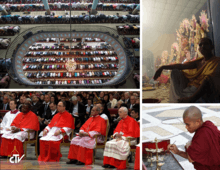
Hinduism is followed by 8.5 percent of the population;[330] most are Bengali Hindus, and some are members of ethnic minority groups. Bangladeshi Hindus are the country's second-largest religious group and the third-largest Hindu community in the world, after those in India and Nepal. Hindus in Bangladesh are evenly distributed, with concentrations in Gopalganj, Dinajpur, Sylhet, Sunamganj, Mymensingh, Khulna, Jessore, Chittagong and parts of the Chittagong Hill Tracts. The festivals of Durga's Return and Krishna's Birthday are public holidays.
Buddhism is the third-largest religion, at 0.6 percent. Bangladeshi Buddhists are concentrated among ethnic groups in the Chittagong Hill Tracts (particularly the Chakma, Marma and Tanchangya peoples), while coastal Chittagong is home to a large number of Bengali Buddhists. Although the Mahayana school of Buddhism was historically prevalent in the region, Bangladeshi Buddhists today adhere to the Theravada school. Buddha's Birthday is a public holiday. The chief Buddhist priests are based at a monastery in Chittagong.
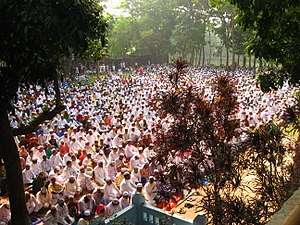
Christianity is the fourth-largest religion, at 0.4 percent.[334] Roman Catholicism is the largest denomination among Bangladeshi Christians. Bengali Christians are spread across the country; while there are many Christians among minority ethnic groups in the Chittagong Hill Tracts (southeastern Bangladesh) and within the Garo tribe of Mymensingh (north-central Bangladesh). The country also has Protestant, Baptist and Oriental Orthodox churches. Christmas is a public holiday.
The Constitution of Bangladesh declares Islam the state religion, but bans religion-based politics. It proclaims equal recognition of Hindus, Buddhists, Christians and people of all faiths.[335] In 1972, Bangladesh was South Asia's first constitutionally-secular country.[336] Article 12 of the constitution continues to call for secularism, the elimination of interfaith tensions and prohibits the abuse of religion for political purposes and any discrimination against, or persecution of, persons practising a particular religion.[337] Article 41 of the constitution subjects religious freedom to public order, law and morality; it gives every citizen the right to profess, practice or propagate any religion; every religious community or denomination the right to establish, maintain and manage its religious institutions; and states that no person attending any educational institution shall be required to receive religious instruction, or to take part in or to attend any religious ceremony or worship, if that instruction, ceremony or worship relates to a religion other than his own.[338]
Education
Bangladesh has a literacy rate of 72.9 percent as of 2018: 75.7% for males and 70.09% for females. The country's educational system is three-tiered and heavily subsidised, with the government operating many schools at the primary, secondary and higher-secondary levels and subsidising many private schools. In the tertiary-education sector, the Bangladeshi government funds over 45 state universities[339] through the University Grants Commission.
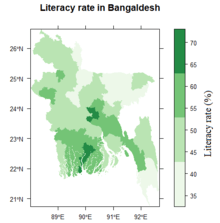
The education system is divided into five levels: primary (first to fifth grade), junior secondary (sixth to eighth grade), secondary (ninth and tenth grade), higher secondary (11th and 12th grade) and tertiary.[340] Five years of secondary education (including junior secondary) ends with a Secondary School Certificate (SSC) examination. Since 2009, the Primary Education Closing (PEC) examination has also been introduced. Students who pass the PEC examination proceed to secondary or matriculation training, culminating in the SSC examination.[340]
Students who pass the PEC examination proceed to three years of junior-secondary education, culminating in the Junior School Certificate (JSC) examination. Students who pass this examination proceed to two years of secondary education, culminating in the SSC examination. Students who pass this examination proceed to two years of higher-secondary education, culminating in the Higher Secondary School Certificate (HSC) examination.[340]
Education is primarily in Bengali, but English is commonly taught and used. Many Muslim families send their children to part-time courses or full-time religious education in Bengali and Arabic in madrasas.[340]
Bangladesh conforms with UNESCO's Education For All (EFA) objectives, the UN Millennium Development Goals (MDG) and other international declarations. Article 17 of the Bangladesh Constitution provides that all children between the ages of six and ten years receive a basic education free of charge.
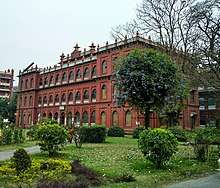
Universities in Bangladesh are of three general types: public (government-owned and -subsidized), private (privately owned universities) and international (operated and funded by international organisations). Bangladesh has 46 public,[341] 105 private[342] and two international universities; Bangladesh National University has the largest enrolment, and the University of Dhaka (established in 1921) is the oldest. University of Chittagong (established in 1966) is the largest University (Campus: Rural, 2,100 acres (8.5 km2)) . Islamic University of Technology, commonly known as IUT, is a subsidiary of the Organisation of the Islamic Cooperation (OIC, representing 57 countries in Asia, Africa, Europe and South America). Asian University for Women in Chittagong is the preeminent South Asian liberal-arts university for women, representing 14 Asian countries; its faculty hails from notable academic institutions in North America, Europe, Asia, Australia and the Middle East.[343] As in Bangladesh, Agriculture sector is the largest contributor (more than 20%) to GDP[344] and Agricultural Sciences are well developed[345]it has 6 Public research based Agricultural University, they are Bangabandhu Sheikh Mujibur Rahman Agricultural University, Bangladesh Agricultural University, Sher-e-Bangla Agricultural University, Sylhet Agricultural University, Khulna Agricultural University, Chittagong Veterinary and Animal Sciences University.[346][347][348] BUET, CUET, KUET and RUET are Bangladesh's four public engineering universities. BUTex and DUET are two specialised engineering universities; BUTex specialises in textile engineering, and DUET offers higher education to diploma engineers. The NITER is a specialised public-private partnership institute which provides higher education in textile engineering. Science and technology universities include SUST, HSTU, PUST, JUST, PSTU, MBSTU and NSTU. Bangladeshi universities are accredited by and affiliated with the University Grants Commission (UGC), created by Presidential Order 10 in 1973.[349]
Medical education is provided by 29 government and private medical colleges. All medical colleges are affiliated with the Ministry of Health and Family Welfare.
Bangladesh's 2015 literacy rate rose to 71 percent due to education modernisation and improved funding, with 16,087 schools and 2,363 colleges receiving Monthly Pay Order (MPO) facilities. According to then education minister Nurul Islam Nahid, 27,558 madrasas and technical and vocational institutions were enlisted for the facility. 6,036 educational institutions were outside MPO coverage, and the government enlisted 1,624 private schools for MPO in 2010.[350][351]
Health
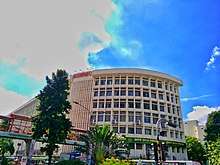
Healthcare facilities in Bangladesh is considered less than adequate, although they have improved as poverty levels have decreased significantly. Findings from a recent study in Chakaria (a rural Upazila under Cox's Bazar District) revealed that the "village doctors", practicing allopathic medicine without formal training, were reported to have provided 65% of the healthcare sought for illness episodes occurring within 14 days prior to the survey. Formally-trained providers made up only four percent of the total health workforce. The Future Health Systems survey indicated significant deficiencies in the treatment practices of village doctors, with widespread harmful and inappropriate drug prescribing.[352] Receiving health care from informal providers is encouraged.[353]
A 2007 study of 1,000 households in rural Bangladesh found that direct payments to formal and informal healthcare providers and indirect costs (loss of earnings because of illness) associated with illness were deterrents to accessing healthcare from qualified providers.[352] A community survey of 6,183 individuals in rural Bangladesh found a gender difference in treatment-seeking behaviour, with women less likely to seek treatment than to men.[354] The use of skilled birth attendant (SBA) services, however, rose from 2005 to 2007 among women from all socioeconomic quintiles except the highest.[355] A health watch, a pilot community-empowerment tool, was successfully developed and implemented in south-eastern Bangladesh to improve the uptake and monitoring of public-health services.[356]
Bangladesh's poor health conditions are attributed to the lack of healthcare provision by the government. According to a 2010 World Bank report, 2009 healthcare spending was 3.35 percent of the country's GDP.[357] Government spending on healthcare that year was 7.9 percent of the total budget; out-of-pocket expenditures totalled 96.5 percent.[357] According to the government sources, the number of hospital beds is 8 per 10,000 population (as of 2015).[358]
Malnutrition has been a persistent problem in Bangladesh, with the World Bank ranking the country first in the number of malnourished children worldwide.[359][360] More than 54% of preschool-age children are stunted, 56% are underweight and more than 17% are wasted.[361] More than 45 percent of rural families and 76 percent of urban families were below the acceptable caloric-intake level.[362]
Culture
Visual arts

The recorded history of art in Bangladesh can be traced to the 3rd century BCE, when terracotta sculptures were made in the region. In classical antiquity, a notable school of sculptural Hindu, Jain and Buddhist art developed in the Pala Empire and the Sena dynasty. Islamic art evolved since the 14th century. The architecture of the Bengal Sultanate saw a distinct style of domed mosques with complex niche pillars that had no minarets. Mughal Bengal's most celebrated artistic tradition was the weaving of Jamdani motifs on fine muslin, which is now classified by UNESCO as an intangible cultural heritage. Jamdani motifs were similar to Iranian textile art (buta motifs) and Western textile art (paisley). The Jamdani weavers in Dhaka received imperial patronage.[65][363] Ivory and brass were also widely used in Mughal art. Pottery is widely used in Bengali culture.
The modern art movement in Bangladesh took shape during the 1950s, particularly with the pioneering works of Zainul Abedin. East Bengal developed its own modernist painting and sculpture traditions, which were distinct from the art movements in West Bengal. The Art Institute Dhaka has been an important center for visual art in the region. Its annual Bengali New Year parade was enlisted as an intangible cultural heritage by UNESCO in 2016.
Modern Bangladesh has produced many of South Asia's leading painters, including SM Sultan, Mohammad Kibria, Shahabuddin Ahmed, Kanak Chanpa Chakma, Kafil Ahmed, Saifuddin Ahmed, Qayyum Chowdhury, Rashid Choudhury, Quamrul Hassan, Rafiqun Nabi and Syed Jahangir, among others. Novera Ahmed and Nitun Kundu were the country's pioneers of modernist sculpture.
In recent times, photography as a medium of art has become popular. Biennial Chobi Mela is considered the largest photography festival in Asia.[364]
Literature

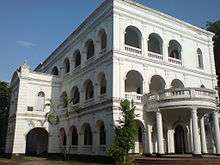
The oldest evidence of writing in Bangladesh is the Mahasthan Brahmi Inscription, which dates back to the 3rd century BCE.[365] In the Gupta Empire, Sanskrit literature thrived in the region. Bengali developed from Sanskrit and Magadhi Prakrit in the 8th to 10th century. Bengali literature is a millennium-old tradition; the Charyapadas are the earliest examples of Bengali poetry. Sufi spiritualism inspired many Bengali Muslim writers. During the Bengal Sultanate, medieval Bengali writers were influenced by Arabic and Persian works. The Chandidas are the notable lyric poets from the early Medieval Age. Syed Alaol was a noted secular poet and translator from the Arakan region. The Bengal Renaissance shaped the emergence of modern Bengali literature, including novels, short stories and science fiction. Rabindranath Tagore was the first non-European laureate of the Nobel Prize in Literature and is described as the Bengali Shakespeare.[366] Kazi Nazrul Islam was a revolutionary poet who espoused political rebellion against colonialism and fascism. Begum Rokeya is regarded as the pioneer feminist writer of Bangladesh.[367] Other renaissance icons included Michael Madhusudan Dutt and Sarat Chandra Chattopadhyay. The writer Syed Mujtaba Ali is noted for his cosmopolitan Bengali worldview.[368] Jasimuddin was a renowned pastoral poet. Shamsur Rahman was the poet laureate of Bangladesh for many years. Al Mahmud is considered one of the greatest Bengali poets to have emerged in the 20th century. Farrukh Ahmed, Sufia Kamal, and Nirmalendu Goon are important figures of modern Bangladeshi poetry. Ahmed Sofa is regarded as the most important Bangladeshi intellectual in the post-independence era. Humayun Ahmed was a popular writer of modern Bangladeshi magical realism and science fiction. Notable writers of Bangladeshi fictions include Mir Mosharraf Hossain, Akhteruzzaman Elias, Shahidul Zahir, Rashid Karim, Mahmudul Haque, Syed Waliullah, Shahidullah Kaiser, Shawkat Osman, Selina Hossain, Taslima Nasreen, Haripada Datta, Razia Khan, Anisul Hoque, and Bipradash Barua. Many Bangladeshi writers, such as Muhammad Zafar Iqbal, Farah Ghuznavi and Rashid Askari are acclaimed for their short stories.
The annual Ekushey Book Fair and Dhaka Literature Festival, organised by the Bangla Academy, are among the largest literary festivals in South Asia.
Women in Bangladesh
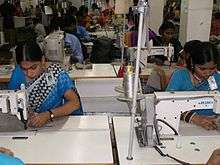
Although, as of 2015, several women occupied major political office in Bangladesh, its women continue to live under a patriarchal social regime where violence is common.[370] Whereas in India and Pakistan women participate less in the workforce as their education increases, the reverse is the case in Bangladesh.[370]
Bengal has a long history of feminist activism dating back to the 19th century. Begum Rokeya and Faizunnessa Chowdhurani played an important role in emancipating Bengali Muslim women from purdah, prior to the country's division, as well as promoting girls' education. Several women were elected to the Bengal Legislative Assembly in the British Raj. The first women's magazine, Begum, was published in 1948.
In 2008, Bangladeshi female workforce participation stood at 26%.[371] Women dominate blue collar jobs in the Bangladeshi garment industry. Agriculture, social services, healthcare and education are also major occupations for Bangladeshi women, while their employment in white collar positions has steadily increased.
Architecture

The architectural traditions of Bangladesh have a 2,500-year-old heritage.[372] Terracotta architecture is a distinct feature of Bengal. Pre-Islamic Bengali architecture reached its pinnacle in the Pala Empire, when the Pala School of Sculptural Art established grand structures such as the Somapura Mahavihara. Islamic architecture began developing under the Bengal Sultanate, when local terracotta styles influenced medieval mosque construction. The Adina Mosque of United Bengal was the largest mosque built on the Indian subcontinent.[373]
The Sixty Dome Mosque was the largest medieval mosque built in Bangladesh, and is a fine example of Turkic-Bengali architecture. The Mughal style replaced indigenous architecture when Bengal became a province of the Mughal Empire and influenced the development of urban housing. The Kantajew Temple and Dhakeshwari Temple are excellent examples of late medieval Hindu temple architecture. Indo-Saracenic Revival architecture, based on Indo-Islamic styles, flourished during the British period. The zamindar gentry in Bangladesh built numerous Indo-Saracenic palaces and country mansions, such as the Ahsan Manzil, Tajhat Palace, Dighapatia Palace, Puthia Rajbari and Natore Rajbari.
.jpg)
Bengali vernacular architecture is noted for pioneering the bungalow. Bangladeshi villages consist of thatched roofed houses made of natural materials like mud, straw, wood and bamboo. In modern times, village bungalows are increasingly made of tin.
Muzharul Islam was the pioneer of Bangladeshi modern architecture. His varied works set the course of modern architectural practice in the country. Islam brought leading global architects, including Louis Kahn, Richard Neutra, Stanley Tigerman, Paul Rudolph, Robert Boughey and Konstantinos Doxiadis, to work in erstwhile East Pakistan. Louis Kahn was chosen to design the National Parliament Complex in Sher-e-Bangla Nagar. Kahn's monumental designs, combining regional red brick aesthetics, his own concrete and marble brutalism and the use of lakes to represent Bengali geography, are regarded as one of the masterpieces of the 20th century. In more recent times, award-winning architects like Rafiq Azam have set the course of contemporary architecture by adopting influences from the works of Islam and Kahn.
Performing arts
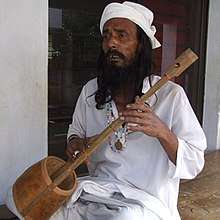
Theatre in Bangladesh includes various forms with a history dating back to the 4th century CE.[374] It includes narrative forms, song and dance forms, supra-personae forms, performances with scroll paintings, puppet theatre and processional forms.[374] The Jatra is the most popular form of Bengali folk theatre. The dance traditions of Bangladesh include indigenous tribal and Bengali dance forms, as well as classical Indian dances, including the Kathak, Odissi and Manipuri dances.
The music of Bangladesh features the Baul mystical tradition, listed by UNESCO as a Masterpiece of Intangible Cultural Heritage.[375] Fakir Lalon Shah popularized Baul music in the country in the 18th century and it has been one of the most popular music genera in the country since then. Most modern Bauls are devoted to Lalon Shah.[376] Numerous lyric-based musical traditions, varying from one region to the next, exist, including Gombhira, Bhatiali and Bhawaiya. Folk music is accompanied by a one-stringed instrument known as the ektara. Other instruments include the dotara, dhol, flute, and tabla. Bengali classical music includes Tagore songs and Nazrul Sangeet. Bangladesh has a rich tradition of Indian classical music, which uses instruments like the sitar, tabla, sarod and santoor.[377] Sabina Yasmin and Runa Laila are considered the leading playback singers in the modern time, while musician Ayub Bachchu is credited with popularising Bengali rock music in Bangladesh.[378]
Textiles
_LACMA_AC1994.131.1.jpg)
The Nakshi Kantha is a centuries-old embroidery tradition for quilts, said to be indigenous to eastern Bengal (i.e. Bangladesh). The sari is the national dress for Bangladeshi women. Mughal Dhaka was renowned for producing the finest Muslin saris, as well as the famed Dhakai and Jamdani, the weaving of which is listed by UNESCO as one of the masterpieces of humanity's intangible cultural heritage.[379] Bangladesh also produces the Rajshahi silk. The shalwar kameez is also widely worn by Bangladeshi women. In urban areas some women can be seen in western clothing. The kurta and sherwani are the national dress of Bangladeshi men; the lungi and dhoti are worn by them in informal settings. Aside from ethnic wear, domestically tailored suits and neckties are customarily worn by the country's men in offices, in schools and at social events.
The handloom industry supplies 60–65% of the country's clothing demand.[380] The Bengali ethnic fashion industry has flourished in the changing environment of the fashion world. The retailer Aarong is one of the most successful ethnic wear brands in South Asia. The development of the Bangladesh textile industry, which supplies leading international brands, has promoted the production and retail of modern Western attire locally, with the country now having a number of expanding local brands like Westecs and Yellow. Bangladesh is the world's second largest garments exporter. Among Bangladesh's fashion designers, Bibi Russell has received international acclaim for her "Fashion for Development" shows.[381]
Cuisine
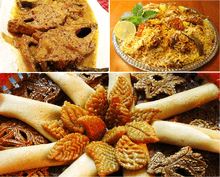
White rice is the staple of Bangladeshi cuisine, along with many vegetables and lentils. Rice preparations also include Bengali biryanis, pulaos, and khichuris. Mustard sauce, ghee, sunflower oil and fruit chutneys are widely used in Bangladeshi cooking. Fish is the main source of protein in Bengali cuisine. The Hilsa is the national fish and immensely popular across Bangladesh. Other kinds of fish eaten include rohu, butterfish, catfish, tilapia and barramundi. Fish eggs are a gourmet delicacy. Seafood holds an important place in Bengali cuisine, especially lobsters, shrimps and dried fish. Meat consumption includes chicken, beef, mutton, venison, duck and squab. In Chittagong, Mezban feasts are a popular tradition featuring the serving of hot beef curry. In Sylhet, the shatkora lemons are used to marinate dishes. In the tribal Hill Tracts, bamboo shoot cooking is prevalent. Bangladesh has a vast spread of desserts, including distinctive sweets like Rôshogolla, Rôshomalai, Chomchom, Mishti Doi and Kalojaam. Pithas are traditional boiled desserts made with rice or fruits. Halwa is served during religious festivities. Naan, paratha, luchi and bakarkhani are the main local breads. Milk tea is offered to guests as a gesture of welcome and is the most common hot beverage in the country. Kebabs are widely popular across Bangladesh, particularly seekh kebabs, chicken tikka and shashliks.
Bangladesh shares its culinary heritage with the neighbouring Indian state of West Bengal. The two regions have several differences, however. In Muslim-majority Bangladesh, meat consumption is greater; whereas in Hindu-majority West Bengal, vegetarianism is more prevalent. The Bangladeshi diaspora dominates the South Asian restaurant industry in many Western countries, particularly in the United Kingdom.
Festivals
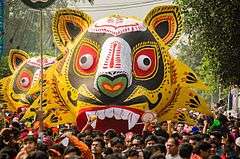
Pahela Baishakh, the Bengali new year, is the major festival of Bengali culture and sees widespread festivities. Of the major holidays celebrated in Bangladesh, only Pahela Baishakh comes without any pre-existing expectations (specific religious identity, culture of gift-giving, etc.) and has become an occasion for celebrating the simpler, rural roots of the Bengal. Other cultural festivals include Nabonno, and Poush Parbon both of which are Bengali harvest festivals.
The Muslim festivals of Eid al-Fitr, Eid al-Adha, Milad un Nabi, Muharram, Chand Raat, Shab-e-Barat; the Hindu festivals of Durga Puja, Janmashtami and Rath Yatra; the Buddhist festival of Buddha Purnima, which marks the birth of Gautama Buddha, and Christian festival of Christmas are national holidays in Bangladesh and see the most widespread celebrations in the country. The two Eids are celebrated with long streak of public holidays and give the city-dwellers opportunity to celebrate the festivals with their families outside city.
Alongside are national days like the remembrance of 21 February 1952 Language Movement Day (declared as International Mother Language Day by UNESCO in 1999),[382] Independence Day and Victory Day. On Language Movement Day, people congregate at the Shaheed Minar in Dhaka to remember the national heroes of the Bengali Language Movement. Similar gatherings are observed at the National Martyrs’ Memorial on Independence Day and Victory Day to remember the national heroes of the Bangladesh Liberation War. These occasions are celebrated with public ceremonies, parades, rallies by citizens, political speeches, fairs, concerts, and various other public and private events, celebrating the history and traditions of Bangladesh. TV and radio stations broadcast special programs and patriotic songs, and many schools and colleges organise fairs, festivals, and concerts that draw the participation of citizens from all levels of Bangladeshi society.[383]
Sports
.jpg)
In rural Bangladesh, several traditional indigenous sports such as Kabaddi, Boli Khela, Lathi Khela and Nouka Baich remain fairly popular. While Kabaddi is the national sport[384] Cricket is the most popular sport in the country followed by football. The national cricket team participated in their first Cricket World Cup in 1999 and the following year was granted Test cricket status. Bangladesh reached the quarter-final of the 2015 Cricket World Cup, the semi-final of the 2017 ICC Champions Trophy and they reached the final of the Asia Cup 3 times – in 2012, 2016 and 2018. In February 2020, the Bangladesh youth national cricket team won the men's Under-19 Cricket World Cup, held in South Africa. This was Bangladesh's first World Cup victory.[385][386]
Women's sports saw significant progress in the 2010s decade in Bangladesh. In 2018 the Bangladesh women's national cricket team won the 2018 Women's Twenty20 Asia Cup defeating India women's national cricket team in the final.[387] Bangladesh women's national football team has also registered some success at regional level, especially the Under-15 and Under-18 teams.
Football is the another popular sport in Bangladesh alongside cricket[388] and is governed by the Bangladesh Football Federation (BFF). Football tournaments are regularly organised in and outside Dhaka and football fever grips the nation during every FIFA World Cup. On 4 November 2018, Bangladesh national under-15 football team won the 2018 SAFF U-15 Championship, defeating Pakistan national under-15 football team in the final.[389] Bangladesh archers Ety Khatun and Roman Sana won several gold medals winning all the 10 archery events (both individual, and team events) in the 2019 South Asian Games.[390]
The National Sports Council regulates 42 sporting federations.[391] Athletics, swimming, archery, boxing, volleyball, weight-lifting and wrestling and different forms of martial arts remain popular. Chess is very popular in Bangladesh. Bangladesh has five grandmasters in chess. Among them, Niaz Murshed was the first grandmaster in South Asia.[392] In 2010, mountain climber Musa Ibrahim became the first Bangladeshi climber to conquer Mount Everest.[393] He climbed the top of the summit of Mount Everest.[394] Wasfia Nazreen is the first Bangladeshi climber to climb the Seven Summits, which are the highest mountains of each of the seven continents of the world.[395]
Bangladesh hosts a number of international tournaments. Bangabandhu Cup is an international football tournament hosted in the country. Bangladesh hosted the South Asian Games several times. In 2011, Bangladesh co-hosted the ICC Cricket World Cup 2011 with India and Sri Lanka. The 2014 ICC World Twenty20 championship was solely hosted by Bangladesh. Bangladesh hosted the Asia Cup Cricket Tournament in 2000, 2012, 2014 and 2016.
Media and cinema
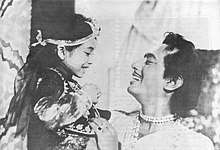
The Bangladeshi press is diverse, outspoken and privately owned. Over 200 newspapers are published in the country. Bangladesh Betar is the state-run radio service.[396] The British Broadcasting Corporation operates the popular BBC Bangla news and current affairs service. Bengali broadcasts from Voice of America are also very popular. Bangladesh Television (BTV) is the state-owned television network. There more than 20 privately owned television networks, including several news channels. Freedom of the media remains a major concern, due to government attempts at censorship and the harassment of journalists.
The cinema of Bangladesh dates back to 1898, when films began screening at the Crown Theatre in Dhaka. The first bioscope on the subcontinent was established in Dhaka that year. The Dhaka Nawab Family patronised the production of several silent films in the 1920s and 30s. In 1931, the East Bengal Cinematograph Society released the first full-length feature film in Bangladesh, titled the Last Kiss. The first feature film in East Pakistan, Mukh O Mukhosh, was released in 1956. During the 1960s, 25–30 films were produced annually in Dhaka. By the 2000s, Bangladesh produced 80–100 films a year. While the Bangladeshi film industry has achieved limited commercial success, the country has produced notable independent filmmakers. Zahir Raihan was a prominent documentary-maker who was assassinated in 1971. The late Tareque Masud is regarded as one of Bangladesh's outstanding directors for his critically acclaimed films on social issues.[397][398] Masud was honoured by FIPRESCI at the 2002 Cannes Film Festival for his film The Clay Bird. Tanvir Mokammel, Mostofa Sarwar Farooki, Humayun Ahmed, Alamgir Kabir, and Chashi Nazrul Islam are some of the prominent directors of Bangladeshi cinema. Bangladesh have very active film society culture. its started in 1963 at Dhaka. Now around 40 Film Society active in all over Bangladesh. Federation of Film Societies of Bangladesh is the parent organisation of the film society movement of Bangladesh. Active film societies include the Rainbow Film Society, Children's Film Society, Moviyana Film Society and Dhaka University Film Society.
Museums and libraries
The Varendra Research Museum is the oldest museum in Bangladesh. It houses important collections from both the pre-Islamic and Islamic periods, including the sculptures of the Pala-Sena School of Art and the Indus Valley Civilization; as well as Sanskrit, Arabic and Persian manuscripts and inscriptions. The Ahsan Manzil, the former residence of the Nawab of Dhaka, is a national museum housing collections from the British Raj. It was the site of the founding conference of the All India Muslim League and hosted many British Viceroys in Dhaka.
The Tajhat Palace Museum preserves artefacts of the rich cultural heritage of North Bengal, including Hindu-Buddhist sculptures and Islamic manuscripts. The Mymensingh Museum houses the personal antique collections of Bengali aristocrats in central Bengal. The Ethnological Museum of Chittagong showcases the lifestyle of various tribes in Bangladesh. The Bangladesh National Museum is located in Ramna, Dhaka and has a rich collection of antiquities. The Liberation War Museum documents the Bangladeshi struggle for independence and the 1971 genocide.
In ancient times, manuscripts were written on palm leaves, tree barks, parchment vellum and terracotta plates and preserved at monasteries known as viharas. The Hussain Shahi dynasty established royal libraries during the Bengal Sultanate. Libraries were established in each district of Bengal by the zamindar gentry during the Bengal Renaissance in the 19th century. The trend of establishing libraries continued until the beginning of World War II. In 1854, four major public libraries were opened, including the Bogra Woodburn Library, the Rangpur Public Library, the Jessore Institute Public Library and the Barisal Public Library.
The Northbrook Hall Public Library was established in Dhaka in 1882 in honour of Lord Northbrook, the Governor-General. Other libraries established in the British period included the Victoria Public Library, Natore (1901), the Sirajganj Public Library (1882), the Rajshahi Public Library (1884), the Comilla Birchandra Library (1885), the Shah Makhdum Institute Public Library, Rajshahi (1891), the Noakhali Town Hall Public Library (1896), the Prize Memorial Library, Sylhet (1897), the Chittagong Municipality Public Library (1904) and the Varendra Research Library (1910). The Great Bengal Library Association was formed in 1925.[400] The Central Public Library of Dhaka was established in 1959. The National Library of Bangladesh was established in 1972. The World Literature Center, founded by Ramon Magsaysay Award winner Abdullah Abu Sayeed, is noted for operating numerous mobile libraries across Bangladesh and was awarded the UNESCO Jon Amos Comenius Medal.
References
- "National Symbols→National march". Bangladesh Tourism Board. Bangladesh: Ministry of Civil Aviation & Tourism. Archived from the original on 28 December 2016. Retrieved 21 February 2015.
In 13 January 1972, the ministry of Bangladesh has adopted this song as a national marching song on its first meeting after the country's independence.
- "Article 3. The state language". The Constitution of the People's Republic of Bangladesh. bdlaws.minlaw.gov.bd. Ministry of Law, The People's Republic of Bangladesh. Retrieved 1 February 2017.
- "Bānlādēśakē jānuna" জানুন [Discover Bangladesh] (in Bengali). National Web Portal of Bangladesh. Archived from the original on 16 February 2015. Retrieved 13 February 2015.
- "Bangladesh 2015 International Religious Freedom Report" (PDF). US Department of State. Retrieved 3 December 2017.
- The Constitution of the People's Republic of Bangladesh. bdlaws.minlaw.gov.bd. Ministry of Law, The People's Republic of Bangladesh. Retrieved 17 May 2019.
Article 2A. – The state religion and Article 12. – Secularism and freedom of religion
- "South Asia :: Bangladesh — The World Factbook - Central Intelligence Agency". www.cia.gov. Retrieved 6 July 2020.
- ""World Population prospects – Population division"". population.un.org. United Nations Department of Economic and Social Affairs, Population Division. Retrieved 9 November 2019.
- ""Overall total population" – World Population Prospects: The 2019 Revision" (xslx). population.un.org (custom data acquired via website). United Nations Department of Economic and Social Affairs, Population Division. Retrieved 9 November 2019.
- Data Archived 4 September 2011 at the Wayback Machine. Census – Bangladesh Bureau of Statistics.
- "World Economic Outlook Database, October 2019". International Monetary Fund. Retrieved 8 December 2019.
- FHM Humayan Kabir (8 June 2020). "Budget for FY '21: Govt set to target $2,326 per-capita income". The Financial Express. Retrieved 14 June 2020.
- "Gini Index". Knoema. Archived from the original on 7 September 2013. Retrieved 3 October 2018.
- "Human Development Report 2019" (PDF). United Nations Development Programme. 10 December 2019. Retrieved 10 December 2019.
- "English pronunciation of Bangladesh". Cambridge Dictionary. Cambridge Dictionary. Retrieved 26 March 2020.
- "SOUTH ASIA :: BANGLADESH". Cia.gov. Central Intelligence Agency. Retrieved 19 June 2019.
- Frank E. Eyetsemitan; James T. Gire (2003). Aging and Adult Development in the Developing World: Applying Western Theories and Concepts. Greenwood Publishing Group. p. 91. ISBN 978-0-89789-925-3.
- Raj Kumar (2003). Essays on Ancient India. Discovery Publishing House. p. 199. ISBN 978-81-7141-682-0.
- Esposito, John L., ed. (2004). The Islamic World: Past and Present. Volume 1: Abba – Hist. Oxford University Press. p. 174. ISBN 978-0-19-516520-3. Archived from the original on 20 December 2017. Retrieved 29 August 2017.
- Jacobs, Frank (6 January 2013). "Peacocks at Sunset". The New York Times. Archived from the original on 14 July 2012. Retrieved 15 July 2012.
- Anwar S. Dil (2000). Bengali language movement to Bangladesh. Ferozsons. ISBN 978-969-0-01577-8.
- Robert S. Stern (2000). Democracy and Dictatorship in South Asia: Dominant Classes and Political Outcomes in India, Pakistan, and Bangladesh. Praeger Publishers. ISBN 978-0-275-97041-3.
- Rich Morin (18 July 2013). "The most (and least) culturally diverse countries in the world". Pew Research Center. Retrieved 19 June 2020.
- "Most Diverse Countries 2020". World Population Review. Retrieved 19 June 2020.
- "Mapping the Global Muslim Population: A Report on the Size and Distribution of the World's Muslim Population". Pew Research Center. 7 October 2009. Retrieved 30 November 2019.
- Oosterveld, Willem; Torossian, Bianca. "A Balancing Act: The Role of Middle Powers in Contemporary Diplomacy". Strategic Monitor 2018–2019. Clingendael Institute. Retrieved 25 May 2019.
- Lisa Schlein (3 March 2020). "Rohingya Refugee Crisis Has Bangladesh, UN Calling for Help | Voice of America – English". VOA News. Archived from the original on 5 March 2020.
- Zafarullah, Habib; Siddiquee, Noore Alam (1 December 2001). "Dissecting Public Sector Corruption in Bangladesh: Issues and Problems of Control". Public Organization Review. 1 (4): 465–486. doi:10.1023/A:1013740000213. ISSN 1566-7170.
- Braun, David Maxwell (20 October 2010). "Bangladesh, India Most Threatened by Climate Change, Risk Study Finds". National Geographic. Archived from the original on 3 May 2016. Retrieved 14 July 2017.
- RIYAZU-S-SALĀTĪN: A History of Bengal Archived 15 December 2014 at the Wayback Machine, Ghulam Husain Salim, The Asiatic Society, Calcutta, 1902.
- Land of Two Rivers, Nitish Sengupta
- Abu'l-Fazl. Ain-i-Akbari.
- "Bangladesh: early history, 1000 B.C.–A.D. 1202". Bangladesh: A country study. Washington, DC: Library of Congress. September 1988. Archived from the original on 7 December 2013. Retrieved 1 December 2014.
Historians believe that Bengal, the area comprising present-day Bangladesh and the Indian state of West Bengal, was settled in about 1000 B.C. by Dravidian-speaking peoples who were later known as the Bang. Their homeland bore various titles that reflected earlier tribal names, such as Vanga, Banga, Bangala, Bangal, and Bengal.
- SenGupta, Amitabh (2012). Scroll Paintings of Bengal: Art in the Village. AuthorHouse UK. p. 14. ISBN 9781468579376.
- Sen, Sailendra Nath (1999) [First published 1988]. Ancient Indian History and Civilization. New Age International. p. 281. ISBN 978-81-224-1198-0.
- Keay, John (2000). India: A History. Atlantic Monthly Press. p. 220. ISBN 978-0-87113-800-2.
In C1020 ... launched Rajendra's great northern escapade ... peoples he defeated have been tentatively identified ... 'Vangala-desa where the rain water never stopped' sounds like a fair description of Bengal in the monsoon.
- Ahmed, Salahuddin (2004). Bangladesh: Past and Present. APH Publishing. p. 23. ISBN 978-81-7648-469-5. Archived from the original on 23 December 2016. Retrieved 14 May 2016.
- "But the most important development of this period was that the country for the first time received a name, ie Bangalah." Banglapedia: Islam, Bengal Archived 23 July 2015 at the Wayback Machine
- Sircar, D.C. (1990). Studies in the Geography of Ancient and Medieval India. Motilal Banarsidass. p. 135. ISBN 978-81-208-0690-0. Archived from the original on 10 June 2016. Retrieved 19 April 2016.
- Majumdar, RC, ed. (2003). History of Bengal. B.R. Publishing Corp. ISBN 9386223465.
- Blood, Peter R. (1989). "Early History, 1000 B.C.–A.D. 1202". In Heitzman, James; Worden, Robert (eds.). Bangladesh: A Country Study. Washington, DC: Federal Research Division, Library of Congress. p. 4. Archived from the original on 22 June 2011. Retrieved 17 October 2010.
- Eaton, R.M. (1996). The Rise of Islam and the Bengal Frontier, 1204–1760. University of California Press. ISBN 978-0-520-20507-9. Archived from the original on 6 January 2017. Retrieved 20 June 2015.
- Lewis, David (2011). Bangladesh: Politics, Economy and Civil Society. Cambridge University Press. p. 42. ISBN 978-1-139-50257-3. Archived from the original on 31 January 2018. Retrieved 16 July 2017.
- Pieris, Sita; Raven, Ellen (2010). ABIA: South and Southeast Asian Art and Archaeology Index. Volume Three – South Asia. Brill. p. 116. ISBN 978-90-04-19148-8. Archived from the original on 23 December 2016. Retrieved 11 December 2015.
- Alam, Shafiqul (2012). "Mahasthan". In Islam, Sirajul; Jamal, Ahmed A. (eds.). Banglapedia: National Encyclopedia of Bangladesh (Second ed.). Asiatic Society of Bangladesh.
- Ghosh, Suchandra (2012). "Pundravardhana". In Islam, Sirajul; Jamal, Ahmed A. (eds.). Banglapedia: National Encyclopedia of Bangladesh (Second ed.). Asiatic Society of Bangladesh.
- "Mahasthan Brahmi Inscription – Banglapedia".
- Diodorus Siculus (1940). The Library of History of Diodorus Siculus. Loeb Classical Library. II. Translated by Charles Henry Oldfather. Harvard University Press. OCLC 875854910.
- Hossain, Emran (19 March 2008). "Wari-Bateshwar one of earliest kingdoms". The Daily Star. Archived from the original on 30 June 2017. Retrieved 16 July 2017.
- Olivelle, Patrick (2006). Between the Empires: Society in India 300 BCE to 400 CE. Oxford University Press. p. 6. ISBN 978-0-19-977507-1. Archived from the original on 3 September 2015. Retrieved 20 June 2015.
- Ring, Trudy; Salkin, Robert M.; La Boda, Sharon (1994). International Dictionary of Historic Places: Asia and Oceania. Taylor & Francis. p. 186. ISBN 978-1-884964-04-6. Archived from the original on 6 January 2017. Retrieved 11 December 2015.
- Nanda, J. N (2005). Bengal: the unique state. Concept Publishing Company. p. 10. 2005. ISBN 978-81-8069-149-2.
Bengal [...] was rich in the production and export of grain, salt, fruit, liquors and wines, precious metals and ornaments besides the output of its handlooms in silk and cotton. Europe referred to Bengal as the richest country to trade with.
- Hasan, Perween (2007). Sultans and Mosques: The Early Muslim Architecture of Bangladesh. I.B. Taurus. p. 32. ISBN 978-1-84511-381-0. Archived from the original on 31 January 2018. Retrieved 28 August 2017.
- Ibn Battutah. The Rehla of Ibn Battuta.
- "Isa Khan – Banglapedia". en.Banglapedia.org. Archived from the original on 7 March 2016. Retrieved 19 September 2017.
- "Dhaka – national capital, Bangladesh". Encyclopædia Britannica. Archived from the original on 10 October 2017. Retrieved 19 September 2017.
- Om Prakash, "Empire, Mughal", History of World Trade Since 1450, edited by John J. McCusker, vol. 1, Macmillan Reference USA, 2006, pp. 237–240, World History in Context. Retrieved 3 August 2017
- "The paradise of nations | Dhaka Tribune". Archive.dhakatribune.com. 20 December 2014. Archived from the original on 16 December 2017. Retrieved 7 November 2016.
- John F. Richards (1995), The Mughal Empire, page 202, Cambridge University Press
- Giorgio Riello, Tirthankar Roy (2009). How India Clothed the World: The World of South Asian Textiles, 1500–1850. Brill Publishers. p. 174. ISBN 9789047429975.
- Ray, Indrajit (2011). Bengal Industries and the British Industrial Revolution (1757–1857). Routledge. p. 174. ISBN 978-1-136-82552-1.
- Lawrence E. Harrison, Peter L. Berger (2006). Developing cultures: case studies. Routledge. p. 158. ISBN 9780415952798.
- M. Shahid Alam (2016). Poverty From The Wealth of Nations: Integration and Polarization in the Global Economy since 1760. Springer Science+Business Media. p. 32. ISBN 978-0-333-98564-9.
- John F. Richards (1995), The Mughal Empire, p. 202, Cambridge University Press
- M. Shahid Alam (2016). Poverty From The Wealth of Nations: Integration and Polarization in the Global Economy since 1760. Springer Science+Business Media. p. 32. ISBN 978-0-333-98564-9.
- Khandker, Hissam (31 July 2015). "Which India is claiming to have been colonised?". The Daily Star (Op-ed).
- Maddison, Angus (2003): Development Centre Studies The World Economy Historical Statistics: Historical Statistics, OECD Publishing, ISBN 9264104143, pages 259–261
- Om Prakash, "Empire, Mughal", History of World Trade Since 1450, edited by John J. McCusker, vol. 1, Macmillan Reference US, 2006, pp. 237–240, World History in Context. Retrieved 3 August 2017
- Ray, Indrajit (2011). Bengal Industries and the British Industrial Revolution (1757–1857). Routledge. p. 174. ISBN 978-1-136-82552-1.
- http://www.ucd.ie/t4cms/WP17_11.pdf
- Samaren Roy (1999). The Bengalees: Glimpses of History and Culture. Allied Publishers. p. 72. ISBN 978-81-7023-981-9. Archived from the original on 31 January 2018. Retrieved 30 July 2017.
- "Bengal". Encyclopaedia Iranica. Archived from the original on 30 September 2017. Retrieved 19 September 2017.
- "Persian". Banglapedia. Archived from the original on 11 September 2017. Retrieved 21 September 2017.
- Campbell, John; Watts, William (1760). Memoirs of the Revolution in Bengal, Anno Domini 1757. World Digital Library.
- Robins, Nick. "This Imperious Company — The East India Company and the Modern Multinational — Nick Robins — Gresham College Lectures". Gresham College Lectures. Gresham College. Retrieved 19 June 2015.
- Parshotam Mehra (1985). A Dictionary of Modern History (1707–1947). Oxford University Press. ISBN 0-19-561552-2.
- Taniya Gupta; Antonia Navarro-Tejero, eds. (2014). India in Canada: Canada in India. Cambridge Scholars Publishing. pp. 22–. ISBN 978-1-4438-5571-6.
- Thakur, Baleshwar (1980). Urban Settlements in Eastern India. New Delhi: Concept Publishing Company. pp. 117–. OCLC 729123405.
- "History of the Portuguese in Bengal,Joachim Joseph A. Campos".
- "History of the Portuguese in Bengal".
- "Banglapedia".
- "Cornwallis Code". Encyclopædia Britannica. 4 February 2009. Retrieved 24 February 2017.
- Ray, Indrajit (2011). Bengal Industries and the British Industrial Revolution (1757–1857). Routledge. pp. 7–10. ISBN 978-1-136-82552-1.
- Shombit Sengupta, Bengals plunder gifted the British Industrial Revolution, The Financial Express, 8 February 2010
- Amartya Sen (1981). Poverty and Famines: An Essay on Entitlement and Deprivation. Oxford University Press. p. 39. ISBN 978-0-19-828463-5.
- Fredrik Albritton Jonsson (18 June 2013). Enlightenment's Frontier: The Scottish Highlands and the Origins of Environmentalism. Yale University Press. pp. 167–170. ISBN 978-0-300-16374-2.
- Khan, Moin-Ud-Din. "Haji Shari’at-Allah". Journal of the Pakistan Historical Society, vol. 11, no. 2 p. 106 (1 April 1963).
- "Revisiting the Great Rebellion of 1857". The Daily Star. 13 July 2014.
- "Sir Syed Ahmed Khan and the Aligarh Movement". YourArticleLibrary.com: The Next Generation Library. 4 January 2014. Retrieved 3 April 2016.
- Nitish Sengupta (2001). History of the Bengali-speaking People. UBS Publishers' Distributors. p. 211. ISBN 978-81-7476-355-6.
The Bengal Renaissance can be said to have started with Raja Ram Mohan Roy (1775-1833) and ended with Rabindranath Tagore (1861-1941), although there were many other stalwarts thereafter embodying particular aspects of the unique intellectual and creative ferment.
- "Reimagining the Colonial Bengal Presidency Template (Part I)". Daily Sun.
- "Railway". Banglapedia. Retrieved 15 August 2019.
- "Railways in colonial Bengal". The Daily Star. 8 April 2019. Retrieved 15 August 2019.
- "Eastern Bengal and Assam – Encyclopedia". Theodora.com. Retrieved 24 September 2015.
- Kennedy, Bernard (December 2005). "Ambassador Rezaqul Haider: Mediating for commerce". Diplomat. Ankara, Turkey. Archived from the original on 10 October 2017. Retrieved 30 July 2017.
After the First World War when the great leader Mustafa Kemal Atatürk started his war of independence, the people of Bengal were very spontaneous in giving all sorts of support. To the extent that there is evidence that the womenfolk donated their own bangles and gold ornaments, and the funds were used for the establishment of a bank, the construction of the parliament building and the purchase of armaments and ammunitions to help the war of liberation. As you know our national poet, Nazrul Islam, was the first foreigner to write an epic poem about Mustafa Kemal.
- "Churchill's policies contributed to 1943 Bengal famine – study". The Guardian. 29 March 2019.
- Soumyendra Nath Mukherjee (1987). Sir William Jones: A Study in Eighteenth-century British Attitudes to India. Cambridge University Press. p. 230. ISBN 978-0-86131-581-9. Archived from the original on 31 January 2018. Retrieved 30 July 2017.
- Farahnaz Ispahani (2017). Purifying the Land of the Pure: A History of Pakistan's Religious Minorities. Oxford University Press. p. 8. ISBN 978-0-19-062165-0. Archived from the original on 31 January 2018. Retrieved 29 August 2017.
- Yasmin Saikia (2011). Women, War, and the Making of Bangladesh: Remembering 1971. Duke University Press. p. 34. ISBN 978-0-8223-5038-5.
- Ahmed, K. Anis (16 August 2017). "Opinion – Why Do Bangladeshis Seem Indifferent to Partition?". The New York Times. Archived from the original on 29 August 2017. Retrieved 19 September 2017.
- Abdul Hannan (28 August 2017). "How Partition helped Muslims". Dhaka Tribune (Opinion). Archived from the original on 1 October 2017. Retrieved 19 September 2017.
- Baxter, p. 72
- David S. Lewis; Darren J. Sagar (1992). Political Parties of Asia and the Pacific: A Reference Guide. Longman. p. 36. ISBN 978-0-582-09811-4. Archived from the original on 31 January 2018. Retrieved 30 July 2017."ts present name in December 1953"
- Vale, Lawrence (2014). Architecture, Power and National Identity. Routledge. p. 291. ISBN 978-1-134-72921-0. Archived from the original on 6 January 2017. Retrieved 14 May 2016.
- Terminski, Bogumil (2014). Development-Induced Displacement and Resettlement. Columbia University Press. p. 28. ISBN 978-3-8382-6723-4. Archived from the original on 14 February 2017. Retrieved 20 January 2017.
- Salahuddin Ahmed (2004). Bangladesh: Past and Present. APH Publishing. p. 157. ISBN 978-81-7648-469-5. Archived from the original on 4 May 2016. Retrieved 29 August 2017.
- Zafar Sobhan (17 August 2007). "Tragedy of errors". The Daily Star (Editorial). Archived from the original on 29 August 2017. Retrieved 19 September 2017.
- Muscat, Robert J. (2015). Investing in Peace: How Development Aid Can Prevent or Promote Conflict. Routledge. ISBN 978-1-317-46729-8. Archived from the original on 14 February 2017. Retrieved 20 January 2017.
- "Bangladesh – The "Revolution" of Ayub Khan, 1958–66". Archived from the original on 6 March 2016. Retrieved 11 December 2015.
- Raic, D (2002). Statehood and the Law of Self-Determination. Martinus Nijhoff Publishers. p. 336. ISBN 978-90-411-1890-5. Archived from the original on 14 February 2017. Retrieved 20 January 2017.
- Thomas, Raju G.C. (2003). Yugoslavia Unraveled. Lexington Books. p. 322. ISBN 978-0-7391-0757-7.
- Syed Badrul Ahsan (2 June 2010). "The sky, the mind, the ban culture". The Daily Star (Editorial). Archived from the original on 22 December 2015. Retrieved 11 December 2015.
- Bangladesh cyclone of 1991 Archived 26 August 2009 at the Wayback Machine. Britannica Online Encyclopedia.
- "Bangladesh – Emerging Discontent, 1966–70". Archived from the original on 23 June 2011. Retrieved 11 December 2015.
- Baxter, pp. 78–79
- Ray, Jayanta Kumar (2013). India's Foreign Relations, 1947–2007. Routledge. ISBN 978-1-136-19714-7.
- Thorpe, Edgar (2012). The Pearson General Knowledge Manual. Pearson Education India. p. A.125. ISBN 978-81-317-6190-8.
- Bass, Gary Jonathan (2014). The Blood Telegram: Nixon, Kissinger, and a Forgotten Genocide. Alfred A. Knopf. p. 50. ISBN 978-0-307-70020-9.
That night [25 March] ... The Pakistani military had launched a devastating assault on the Bengalis.
- Siegfried O. Wolf; Jivanta Schöttli; Dominik Frommherz; Kai Fürstenberg; Marian Gallenkamp; Lion König; Markus Pauli (2014). Politics in South Asia: Culture, Rationality and Conceptual Flow. Springer. p. 111. ISBN 978-3-319-09087-0. Archived from the original on 14 February 2017. Retrieved 20 January 2017.
- Bates, Crispin (2013). Subalterns and Raj: South Asia Since 1600. Routledge. p. 191. ISBN 978-1-134-51375-8. Archived from the original on 14 February 2017. Retrieved 20 January 2017.
- Pervez Musharraf (2008). In the Line of Fire. Simon and Schuster. p. 70. ISBN 978-1-84739-596-2.
- Johnston, Faith (2013). Four Miles to Freedom. Random House India. ISBN 978-81-8400-507-3. Archived from the original on 14 February 2017. Retrieved 20 January 2017.
- Totten, Samuel (2012). Plight and Fate of Women During and Following Genocide. Transaction Publishers. p. 47. ISBN 978-1-4128-4759-9. Archived from the original on 14 February 2017. Retrieved 20 January 2017.
- "Bangladesh sets up war crimes court". Archived from the original on 16 December 2015. Retrieved 11 December 2015.
- Benvenisti, Eyal (2012) [First published 1992]. The International Law of Occupation (2nd ed.). Oxford University Press. p. 190. ISBN 978-0-19-163957-9. Archived from the original on 14 February 2017. Retrieved 20 January 2017.
The genuine and widely recognized claim for Bangladeshi self-determination as an entity independent of West Pakistan, coupled with the repulsion caused by the Pakistani measures to suppress that claim convinced global public opinion ... By the time its admission for membership in the United Nations came before the Security Council, in August 1972, Bangladesh had already been recognized by eighty-six countries.
- "In Bangladesh, Ted Kennedy revered". Archived from the original on 22 December 2015. Retrieved 12 December 2015.
- Nelson, Dean (19 October 2012). "Bangladesh to honour Bob Dylan and George Harrison". The Daily Telegraph. Archived from the original on 13 June 2018. Retrieved 18 June 2018.
- "Joan Baez: Singing heroine of 1971 left out of Shommyanona list". The Opinion Pages. 10 April 2012. Archived from the original on 22 December 2015. Retrieved 12 December 2015.
- Womack, Kenneth (2014). Beatles Encyclopedia, The: Everything Fab Four. ABC-CLIO. p. 200. ISBN 978-0-313-39172-9. Archived from the original on 14 February 2017. Retrieved 20 January 2017.
- LaPorte, R (1972). "Pakistan in 1971: The Disintegration of a Nation". Asian Survey. 12 (2): 97–108. doi:10.1525/as.1972.12.2.01p0190a.
- Rummel, Rudolph J. (1997) "Statistics of Democide: Genocide and Mass Murder Since 1900" Archived 21 February 2016 at the Wayback Machine. Transaction Publishers, Rutgers University. ISBN 3-8258-4010-7, Chapter 8, Table 8.2 Pakistan Genocide in Bangladesh Estimates, Sources, and Calculations Archived 4 February 2012 at the Wayback Machine.
- Srinath Raghavan (2013). 1971. Harvard University Press. p. 247. ISBN 978-0-674-73127-1. Archived from the original on 14 February 2017. Retrieved 20 January 2017.
- Sheikh Mujib's Return to Bangladesh – January 10, 1972 Monday. NBC. 23 December 2013. Archived from the original on 17 March 2016. Retrieved 21 December 2015 – via Centre for Bangladesh Genocide Research.
- Lyon, Peter (2008). Conflict Between India and Pakistan: An Encyclopedia. ABC-CLIO. p. 193. ISBN 978-1-57607-712-2.
12 March India's armed forces withdraw from Bangladesh at a ceremonial parade in Dacca.
- Syed Muazzem Ali (19 February 2006). "Bangladesh and the OIC". The Daily Star. Archived from the original on 4 March 2016. Retrieved 21 December 2015.
- Umar, Badruddin (1972). "Bangladesh nationalisation: What does it all mean?". Journal of Contemporary Asia. 2 (3): 328–30. doi:10.1080/00472337285390641.
- David Lewis (2011). Bangladesh: Politics, Economy and Civil Society. Cambridge University Press. ISBN 978-1-139-50257-3. Archived from the original on 6 January 2017. Retrieved 11 December 2015.
- "Mushtaq was worst traitor: attorney general". bdnews24.com. Archived from the original on 10 October 2017. Retrieved 19 September 2017.
- B.Z. Khasru. The Bangladesh Military Coup and the CIA Link. Rupa Publications India Pvt. Ltd. ISBN 978-81-291-3416-5.
- "Bangladesh profile". BBC News. 13 August 2017. Archived from the original on 11 July 2018. Retrieved 19 September 2017.
- "Women and property rights: Who owns Bangladesh?". The Economist (Blog). 21 August 2013. Archived from the original on 7 December 2013. Retrieved 2 December 2013.
- Torild, Skard (2014). Women of power: Half a century of female presidents and prime ministers worldwide. Policy Press. p. 135. ISBN 978-1-4473-1578-0.
- "The Daily Star Web Edition Vol. 5 Num 1007". Archived from the original on 15 September 2018. Retrieved 10 November 2018.
- "Former Bangladeshi PM arrested: reports". ABC News. 16 July 2007. Archived from the original on 22 September 2018. Retrieved 26 December 2018.
- "Ex-PM sued on corruption charges in Bangladesh". International Herald Tribune. 12 February 2009. Archived from the original on 12 February 2009. Retrieved 26 December 2018.
- "Economic Reforms Can Make Bangladesh Grow Faster". Archived from the original on 11 April 2019. Retrieved 9 April 2019.
- Safi, Michael; Ahmed, Redwan (31 December 2018). "Bangladesh PM Hasina wins thumping victory in elections opposition reject as 'farcical'". The Guardian.
- "Hasina's win makes her the longest serving PM of Bangladesh". Archived from the original on 31 December 2018. Retrieved 9 April 2019.
- "Bangladesh election: Opposition demands new vote". BBC News. 30 December 2018. Archived from the original on 11 April 2019. Retrieved 9 April 2019.
- "Statement by the Spokesperson on parliamentary elections in Bangladesh". EEAS – European External Action Service – European Commission. Retrieved 15 August 2019.
- Seth Mydans (21 June 1987). "Life in Bangladesh Delta: On the Edge of Disaster". The New York Times. Archived from the original on 4 November 2017.
- "Ganges River Basin". National Geographic Society. 1 October 2019. Archived from the original on 9 March 2020.
- Aditi Rajagopal. "How the World's Largest Delta Might Slowly Go Under Water". Discovery. Archived from the original on 8 February 2020.
- Suvedī, Sūryaprasāda (2005). International watercourses law for the 21st century. Ashgate Publishing, Ltd. pp. 154–66. ISBN 978-0-7546-4527-6.
- Ali, A. (1996). "Vulnerability of Bangladesh to climate change and sea level rise through tropical cyclones and storm surges". Water, Air, & Soil Pollution. 92 (1–2): 171–79. doi:10.1007/BF00175563 (inactive 4 June 2020).
- ""Bangladesh fights for survival against climate change", by William Wheeler and Anna-Katarina Gravgaard, The Washington Times". Pulitzercenter.org. 18 October 2009. Archived from the original on 24 July 2011. Retrieved 3 July 2010.
- "Bangladesh Delta Plan 2100: Implementation challenges and way forward". The Financial Express. 23 March 2019. Retrieved 24 September 2019.
- "Bangladesh Delta Plan 2100". The Dutch water sector. 20 May 2019. Retrieved 24 September 2019.
- "World Country High Points". peakbagger.com. peakbagger.com.
- "Bangladesh". The World Factbook. CIA.
- "National Web Portal of Bangladesh". Bangladesh Government. 15 September 2015. Archived from the original on 23 September 2015. Retrieved 23 September 2015.
- "Bangladesh". The World Factbook. Langley, Virginia: Central Intelligence Agency. 2012. Archived from the original on 20 July 2015. Retrieved 15 May 2007.
- "Rangpur becomes a divivion". bdnews24.com. 25 January 2010. Archived from the original on 3 September 2015. Retrieved 6 August 2011.
- "Bangladesh changes English spellings of five districts". bdnews24.com. 2 April 2018. Retrieved 1 October 2019.
- Local Government Act, No. 20, 1997
- "Health Bulletin 2016" (PDF). Directorate General of Health Services (DGHS). p. 13. Archived (PDF) from the original on 13 June 2017. Retrieved 11 September 2017.
- Beck, Hylke E.; Zimmermann, Niklaus E.; McVicar, Tim R.; Vergopolan, Noemi; Berg, Alexis; Wood, Eric F. (30 October 2018). "Present and future Köppen-Geiger climate classification maps at 1-km resolution". Scientific Data. 5: 180214. Bibcode:2018NatSD...580214B. doi:10.1038/sdata.2018.214. PMC 6207062. PMID 30375988.
- "Map of Dinajpur". kantaji.com. Archived from the original on 13 July 2011. Retrieved 17 April 2015.
- Alexander, David E. (1999) [1993]. "The Third World". Natural Disasters. Dordrecht: Kluwer Academic Publishers. p. 532. ISBN 978-0-412-04751-0.
- "Beset by Bay's Killer Storms, Bangladesh Prepares and Hopes Archived 11 May 2011 at the Wayback Machine". Los Angeles Times. 27 February 2005
- Haggett, Peter (2002) [2002]. "The Indian Subcontinent". Encyclopedia of World Geography. New York: Marshall Cavendish. pp. 2, 634. ISBN 978-0-7614-7308-4. OCLC 46578454.
- Raju, M. N. A. (10 March 2018). "Disaster Preparedness for Sustainable Development in Bangladesh". Daily Sun. Retrieved 26 September 2019.
- "Bangladesh flood death toll nears 500, thousands ill". Reuters. 15 August 2007. Retrieved 15 August 2007.
- Kulp, Scott A.; Strauss, Benjamin H. (29 October 2019). "New elevation data triple estimates of global vulnerability to sea-level rise and coastal flooding". Nature Communications. 10 (1): 4844. Bibcode:2019NatCo..10.4844K. doi:10.1038/s41467-019-12808-z. ISSN 2041-1723. PMC 6820795. PMID 31664024.
- "Report: Flooded Future: Global vulnerability to sea level rise worse than previously understood". climatecentral.org. 29 October 2019. Retrieved 3 November 2019.
- Chaturvedi, Sanjay (29 April 2016). Climate Change and the Bay of Bengal. Flipside Digital Content Company Inc. ISBN 978-981-4762-01-4.
- Bangladesh Climate Change Strategy and Action Plan, 2008 (PDF). Ministry of Environment and Forests Government of the People's Republic of Bangladesh. 2008. ISBN 978-984-8574-25-6. Archived from the original (PDF) on 7 October 2009.
- Glennon, Robert. "The Unfolding Tragedy of Climate Change in Bangladesh". Archived from the original on 1 December 2017. Retrieved 23 November 2017.
- Bangladesh Delta Plan 2100
- Bangladesh Delta Plan (BDP) 2100
- Beneath Bangladesh: The Next Great Earthquake? Archived 11 August 2011 at the Wayback Machine. earth.columbia.edu (12 July 2011)
- Walker, Brian (21 June 2010). "Study: Millions in Bangladesh exposed to arsenic in drinking water". CNN. Archived from the original on 23 June 2010. Retrieved 3 July 2010.
- "Bangladesh: 77 m poisoned by arsenic in drinking water". BBC News. 19 June 2010. Archived from the original on 23 June 2010. Retrieved 3 July 2010.
- "Bangladesh – Country Profile". cbd.int. Archived from the original on 17 February 2015. Retrieved 16 February 2015.
- Bangladesh | history – geography :: Plant and animal life Archived 3 February 2014 at the Wayback Machine. Encyclopædia Britannica.
- "Flora and Fauna – Bangladesh high commission in India". Bangladesh High Commission, New Delhi. Archived from the original on 20 August 2013.
- Soraya Auer; Anika Hossain (7 July 2012). "Lost Wards of the State". The Daily Star. Archived from the original on 14 February 2015. Retrieved 14 February 2015.
- Peter Haggett (2001). Encyclopedia of World Geography. Marshall Cavendish. p. 2620. ISBN 978-0-7614-7289-6. Archived from the original on 14 February 2017. Retrieved 20 January 2017.
- "Bears in Bangladesh". Bangladesh Bear Project. Archived from the original on 14 February 2015. Retrieved 14 February 2015.
- "6,000 Rare, Large River Dolphins Found in Bangladesh". National Geographic. March 2009. Archived from the original on 12 October 2014. Retrieved 13 February 2015.
- Hossain, Muhammad Selim (23 May 2009). "Conserving biodiversity must for survival". The Daily Star. Archived from the original on 30 May 2015. Retrieved 30 May 2015.
- "Country Trends". Global Footprint Network. Retrieved 9 October 2019.
- "Is Bangladesh becoming an autocracy?". Deutsche Welle. 27 March 2018. Retrieved 15 August 2019.
- "Detail". bti-project.org. Retrieved 15 August 2019.
- "Spirit of Liberation War". The Daily Star. 26 March 2014. Retrieved 15 August 2019.
- Sobhan, Rehman (31 December 2011). "The Spirit of the Liberation War". The Daily Star. Retrieved 7 October 2019.
- Kabir, A. (12 August 2013). "No Meritocracy: Bangladesh's Civil Service". The Diplomat. Retrieved 9 October 2019.
- "President". The Nexus Commonwealth Network. Retrieved 10 October 2019.
- "Amendment to anti-torture law to hinder HR protection, says ASK". New Age | The Most Popular Outspoken English Daily in Bangladesh. Retrieved 15 August 2019.
- Shahid, S. A. (18 January 2019). "Deputy speaker from opposition, no chance for war criminals". The Daily Star. Retrieved 14 October 2019.
- Sial, Omar (October 2008). "A Research Guide to the Legal System of the Peoples' Republic of Bangladesh". GlobaLex. Retrieved 27 April 2015.
- "The Military and Democracy in Bangladesh". press-files.anu.edu.au. Retrieved 19 September 2017.
-
- International Institute for Strategic Studies (14 February 2018). The Military Balance 2018. London: Routledge. ISBN 9781857439557.
- Including service and civilian personnel. See Bangladesh Navy. Retrieved 17 July 2007.
- Armed Forces Division. "Ongoing Operations". afd.gov.bd.
- "New Indian army chief General Bipin Rawat coming to Bangladesh Friday". bdnews24.com. Retrieved 19 September 2017.
- "What Can Be Expected From The India-Bangladesh Defence Deal?". Outlook India. Retrieved 19 September 2017.
- Balachandran, P.K. (12 April 2017). "Rivals India and China woo Bangladesh with aid totalling $46 b". Daily FT. Colombo.
- "Bangladesh ratifies nuclear weapons prohibition treaty". Dhaka Tribune. 28 September 2020.
- Armed Forces Division. "Bangladesh in UN Mission". afd.gov.bd.
- "Foreign Policy – Banglapedia". en.banglapedia.org. Retrieved 19 September 2017.
- "Judgment in Bangladesh-Myanmar Maritime Boundary Dispute – International Law Observer – A blog dedicated to reports, commentary and the discussion of topical issues of international law". internationallawobserver.eu. Retrieved 19 September 2017.
- Alam, Julhas (16 September 2017). "Bangladesh accuses Myanmar of violating its airspace". Daily Press. Associated Press. Retrieved 19 September 2017.
- Safi, Michael (11 September 2017). "Myanmar treatment of Rohingya looks like 'textbook ethnic cleansing', says UN". The Guardian. Retrieved 19 September 2017.
- "Indian papers back strong ties with 'trusted friend' Bangladesh". BBC News. 8 June 2015.
- Mahfuz Anam (9 September 2017). "Rohingya crisis: A concern for the region". The Daily Star (Opinion). Retrieved 19 September 2017.
- "Rohingya aid from India, Morocco, Indonesia arrives". The Daily Star. 14 September 2017. Retrieved 19 September 2017.
- "India's push to save its cows starves Bangladesh of beef". Reuters. 2 July 2015. Retrieved 19 September 2017.
- "Bangladesh-Pakistan Bilateral Trade Statistics" (PDF). Dhaka Chamber of Commerce & Industry. Retrieved 19 September 2017.
- Chowdhury, Syed Tashfin (22 December 2013). "Pakistan-Bangladesh relationship strained". Al Jazeera. Retrieved 29 July 2015.
- Sheikh Shahariar Zaman (18 March 2014). "China biggest arms supplier to Bangladesh". Dhaka Tribune. Archived from the original on 19 September 2017. Retrieved 19 September 2017.
- Sisodia, N.S.; Naidu, G.V.C. (2005). Changing Security Dynamic in Eastern Asia. google.com.bd. ISBN 978-81-86019-52-8. Retrieved 3 December 2015.
- Hasib, Nurul Islam (1 February 2015) First Bangladesh-Japan foreign secretary-level talks on Feb 5. bdnews24.com. Retrieved 27 April 2015.
- "Chapter 4: How Asians View Each Other". pewglobal.org. 14 July 2014. Retrieved 19 September 2017.
- "Bangladesh". state.gov. Retrieved 19 September 2017.
- United States Department of State
- Rezaul Karim (11 June 2016). "Saudi wants active role of Bangladesh". The Daily Star.
- "B'desh should not establish ties with Israel: Experts". 29 August 2010. Retrieved 21 June 2015.
- "Statement by Her Excellency Ms. Dipu Moni, Minister for Foreign Affairs of Bangladesh". Ministry of Foreign Affairs, Dhaka. Archived from the original on 24 December 2013.
- "Bangladesh". U.S. Central Command. Archived from the original on 14 August 2014.
- Haq, Naimul. "Bangladesh Opting for Peace Rather Than Nuclear Arms". IDN-InDepthNews. Retrieved 19 September 2017.
- Shamsul Huda Harun (2001). The Making Of The Prime Minister H.S. Suhra Wardy Inan Anagram Polity 1947–1958. Institute of Liberation Bangabandhu and Bangladesh Studies, National University. ISBN 978-984-783-012-4.
- "Lecture Series – Dr. Kamal Hossain". United Nations. Retrieved 15 August 2019.
- Diplomat, Shakil Bin Mushtaq, The. "Bangladesh Adds Third Gender Option to Voter Forms". The Diplomat. Retrieved 15 August 2019.
- Ashif Islam Shaon (27 April 2016). "Where does Bangladesh stand on homosexuality issue?". Dhaka Tribune. Archived from the original on 5 June 2017. Retrieved 30 May 2017.
- "Bangladesh authorities arrest 27 men on suspicion of being gay". The Independent. 19 May 2017.
- Refugees, United Nations High Commissioner for. "How a Bangladesh court ruling changed the lives of more than 300,000 stateless people". UNHCR. Retrieved 15 August 2019.
- "International labour standards in Bangladesh (ILO in Bangladesh)". ilo.org. Retrieved 15 August 2019.
- "United Nations Treaty Collection". United Nations. Retrieved 15 August 2019.
- "United Nations Treaty Collection". United Nations. Retrieved 15 August 2019.
- "Bangladesh: New Digital Security Act imposes dangerous restrictions on freedom of expression". Amnesty International. Retrieved 15 August 2019.
- Bangladesh. Freedom House. Retrieved 27 April 2015.
- "Bangladesh – Country report – Freedom in the World – 2016". freedomhouse.org. 27 January 2016. Retrieved 12 May 2016.
- "Democracy Index 2014: Democracy and its discontents" (PDF). The Economist – via Sudestada.com.uy.
- "Bangladesh 98th among 162 countries". The Daily Star (Op-ed). 16 August 2014. Retrieved 9 December 2015.
- "Civil society, freedom of speech under attack in Bangladesh: UN". The Daily Star (Op-ed). 5 March 2015. Retrieved 9 December 2015.
- Ridwanul Hoque. "Clashing ideologies". D+C, development and cooperation. Retrieved 21 December 2015.
- Simon Whelan (7 January 2011). "British police trained Bangladeshi death squads". World Socialist Web Site. Retrieved 9 December 2015.
- "Bangladesh: Disband Death Squad". Human Rights Watch. 21 July 2014. Retrieved 9 December 2015.
- "Rights groups demand disbanding of RAB". Deutsche Welle. Retrieved 9 December 2015.
- Fariha Karim (10 May 2011). "Bangladeshi force trained by UK police 'allowed to kill and torture'". The Guardian. Retrieved 9 December 2015.
- "CHT Commission concludes Sixth Mission" (Press release). Kapaeeng Foundation. Archived from the original on 30 January 2016. Retrieved 6 December 2015.
- Suvojit Bagchi (3 December 2015). "Trouble brewing in Chittagong Hill tracts". The Hindu. Retrieved 9 December 2015.
- "Secular state with state religion gives rise to ambiguities". The Independent. Dhaka. Retrieved 9 December 2015.
- Syed Zain Al-Mahmood (1 August 2013). "Bangladesh's Top Islamist Party Banned From Poll – WSJ". The Wall Street Journal. Retrieved 9 December 2015.
- Kevin Bales; et al. "Bangladesh". The Global Slavery Index 2016. The Minderoo Foundation Pty Ltd. Archived from the original on 13 March 2018. Retrieved 13 March 2018.
- Bales, Kevin (2016). Blood and Earth: Modern Slavery, Ecocide, and the Secret to Saving the World (First ed.). New York: Spiegel & Grau. pp. 71–97. ISBN 978-0-8129-9576-3.
- Siddharth, Kara (2012). Bonded Labor: Tackling the System of Slavery in South Asia. New York: Columbia University Press. pp. 104–22.
- McGoogan, Cara; Rashid, Muktadir (23 October 2016). "Satellites reveal 'child slave camps' in Unesco-protected park in Bangladesh". The Telegraph. Retrieved 13 March 2018.
- "Corruption Perceptions Index 2018 – Transparency International". Transparency International. Retrieved 29 January 2017.
- Corruption in Service Sectors: National Household Survey 2015, Transparency International Bangladesh, Dhaka, 2016, p. 1
- Corruption in Service Sectors: National Household Survey, 2015, Transparency International Bangladesh, Dhaka, 2016, p. 1
- Corruption in Service Sectors: National Household Survey 2015, Transparency International Bangladesh, Dhaka, 2016, p. 12
- Corruption in Service Sectors: National Household Survey 2015, Transparency International Bangladesh, Dhaka, 2016, p. 21
- The Business of Bribes: Bangladesh: The Blowback of Corruption, Public Broadcasting Services, Arlington, Virginia, 2009
- "Overview of corruption and anti-corruption in Bangladesh". U4. Retrieved 9 December 2015.
- "ACC largely ineffective". The Daily Star. 21 May 2014. Retrieved 1 June 2016.
- "Anti Corruption Commission and Political Government: An Evaluation of Awami League Regime (2009–2012) | Government and Politics, JU". govpoliju.com. Retrieved 1 June 2016.
- "WELT 2019 | Centre for Economics and Business Research". cebr.com. Retrieved 15 August 2019.
- "Economic Reforms Can Make Bangladesh Grow Faster".
- "Report for Selected Countries and Subjects".
- "Remittance hits record $15.31b". The Daily Star. 3 July 2015. Archived from the original on 26 December 2015. Retrieved 25 December 2015.
- "Balance of payments [Annual Data]". Bangladesh Bank. Retrieved 5 December 2019.
- "Report for Selected Countries and Subjects". International Monetary Fund. Archived from the original on 19 September 2018. Retrieved 19 September 2018.
- "Bangladesh – Country Brief". World Bank. Archived from the original on 15 September 2007. Retrieved 17 December 2015.
- "Bangladesh Gets first Credit Rating". The Daily Star. 7 April 2010. Archived from the original on 14 April 2016. Retrieved 7 April 2010.
- "CIA – The World Factbook". Central Intelligence Agency. Retrieved 5 December 2019.
- "Countries by Commodity". FAOSTAT. Food and Agriculture Organization of the United Nations. 2013. Archived from the original on 13 November 2016. Retrieved 13 November 2016.
- Golub, Stephen; Varma, Abir (February 2014). Fishing Exports and Economic Development of Least Developed Countries: Bangladesh, Cambodia, Comoros, Sierra Leone and Uganda (PDF) (Report). Swarthmore College. p. 23. Archived (PDF) from the original on 24 October 2014. Retrieved 17 February 2015.
- Chevron Policy; Government and Public Affairs. "Bangladesh" (PDF). Chevron. Archived from the original (PDF) on 22 January 2016. Retrieved 23 January 2019.
- Jack Detsch; The Diplomat. "Bangladesh: Asia's New Energy Superpower?". The Diplomat. Archived from the original on 29 December 2016. Retrieved 17 December 2015.
- Hassan, Nazmul (26 March 2005). "Pharmaceutical Sector Growing Fast". Arab News. Archived from the original on 1 October 2015. Retrieved 30 September 2015.
- Lane, EJ (13 February 2015). "Bangladesh's drug industry meets nearly all domestic demand, eyes exports". Fierce Pharma Asia. Archived from the original on 1 October 2015.
- Lakshmi, Aiswarya (10 March 2015). "Bangladesh Mulls Investments in Shipbuilding". Marinelink.com. Archived from the original on 22 December 2015. Retrieved 17 December 2015.
- "Palak: Once Walton may turn into private Hi-Tech Park". Dhaka Tribune. 16 October 2015. Archived from the original on 8 November 2017. Retrieved 17 December 2015.
- Sajjadur Rahman (4 April 2014). "Bank assets go up on steady economic growth". The Daily Star. Archived from the original on 22 December 2015. Retrieved 17 December 2015.
- "Internet growth hinges on local content, cheap phones". The Daily Star. 9 March 2014. Archived from the original on 18 February 2015. Retrieved 18 February 2015.
- "Tentative Lists". Archived from the original on 6 August 2012. Retrieved 6 September 2017.
- "BRAC in business". 18 February 2010. Archived from the original on 7 September 2017. Retrieved 6 September 2017.
- "Bangladesh Microfinance Statistics 2010" (PDF). Archived from the original (PDF) on 22 December 2015. Retrieved 14 December 2015.
- "The Nobel Peace Prize for 2006". Archived from the original on 19 October 2006. Retrieved 6 September 2017.
- Transport – Bangladesh Transport Sector Archived 7 January 2015 at the Wayback Machine. World Bank. Retrieved 27 April 2015.
- Ethirajan, Anbarasan (4 September 2012). "Bangladesh pins hope on Chittagong port". BBC News. Archived from the original on 15 October 2018. Retrieved 21 June 2018.
- "River Port – Banglapedia". en.banglapedia.org. Archived from the original on 7 September 2017. Retrieved 19 September 2017.
- "In pictures: Celebrating 20,000MW of power". Dhaka Tribune. 8 September 2018. Retrieved 4 January 2019.
- Lall, Marie (2009). The Geopolitics of Energy in South Asia. Institute of Southeast Asian Studies. p. 143. ISBN 978-981-230-827-6. Archived from the original on 6 January 2017. Retrieved 14 May 2016.
- "Rosatom to Build Bangladesh's First Nuclear Power Plant | Business". The Moscow Times. 3 October 2013. Archived from the original on 19 February 2016. Retrieved 17 December 2015.
- Woody, Todd (12 May 2014). "Why Green Jobs Are Booming in Bangladesh". The Atlantic. Archived from the original on 6 February 2017. Retrieved 5 March 2017.
-
- World Health Organization; UNICEF. "Joint Monitoring Program". Archived from the original on 16 February 2008. Retrieved 20 October 2010.
Data are based on National Institute of Population Research and Training (Bangladesh); Mitra and Associates (Dhaka); ORC Macro. Measure/DHS+ (Programme) (2005). Bangladesh Demographic and Health Survey, 2004. Dhaka.
- World Health Organization; UNICEF. "Joint Monitoring Program". Archived from the original on 16 February 2008. Retrieved 20 October 2010.
- "Bangladesh". The World Factbook. Central Intelligence Agency. Archived from the original on 20 July 2015. Retrieved 25 September 2013.
- Kar, Kamal; Bongartz, Petra (April 2006). Update on Some Recent Developments in Community-Led Total Sanitation (PDF). Brighton: University of Sussex, Institute of Development Studies. ISBN 1-85864-614-6. Archived from the original (PDF) on 28 May 2008. Retrieved 28 April 2008.
- "Dhaka, Bangladesh. 1985". Archived from the original on 11 March 2016. Retrieved 17 December 2015 – via YouTube.
- "Bangladesh launches its first satellite Bangabandhu-1". The Times of India. 13 May 2018. Retrieved 15 May 2018.
- "Bangladesh Atomic Energy Commission". Baec.org.bd. 22 June 2014. Archived from the original on 4 March 2016. Retrieved 17 December 2015.
- "Bangladesh Best Destination for IT outsourcing". The Daily Star. 8 March 2015. Archived from the original on 16 August 2016. Retrieved 15 August 2016.
- Lonely Planet's Best in Travel. Lonely Planet. 2011. ISBN 978-1-74220-090-3. Archived from the original on 24 February 1999. Retrieved 11 April 2018.
- "Top 10 best value destinations for 2011". Lonely Planet. 2011. Archived from the original on 16 January 2017. Retrieved 11 April 2018.
- "Travel & Tourism Competitiveness Index 2019 edition: Bangladesh" (PDF). World Travel and Tourism Council. Retrieved 18 December 2019.
- "Travel & Tourism Economic Impact 2013: Bangladesh" (PDF). World Travel and Tourism Council. Archived from the original (PDF) on 7 October 2013.
- CO2 Emissions from Fuel Combustion Population 1971–2009 IEA (pdf. pp. 87–89)
- "Bangladesh's Population to Exceed 160 Mln after Final Census Report". English.cri.cn. Archived from the original on 14 January 2012. Retrieved 6 August 2011.
- "Population density – Persons per sq km 2010 Country Ranks". Archived from the original on 24 October 2010. Retrieved 2 October 2010.
- "Socio-Economic Indicators of Bangladesh" (PDF). Bangladesh Economic Review 2018. Ministry of Finance, Bangladesh. 2018. Retrieved 26 April 2019.
- "Poverty & Equity Data Portal". world bank. Archived from the original on 27 December 2018. Retrieved 26 December 2018.
- "The World Bank in Bangladesh". world bank. Archived from the original on 17 December 2018. Retrieved 26 December 2018.
- "Background Note: Bangladesh" . Retrieved 11 June 2008.
- Rashiduzzaman, M (1998). "Bangladesh's Chittagong Hill Tracts Peace Accord: Institutional Features and Strategic Concerns". Asian Survey. 38 (7): 653–70. doi:10.1525/as.1998.38.7.01p0370e. JSTOR 2645754.
- "New Dhaka Jamatkhana seen as a symbol of confidence in Bangladesh – The Ismaili". theismaili.org. 10 October 2012. Archived from the original on 22 February 2015. Retrieved 22 February 2015.
- Note on the nationality status of the Urdu-speaking community in Bangladesh Archived 22 February 2015 at the Wayback Machine. UNHCR – The UN Refugee Agency.
- Population and Housing Census 2011 – Volume 3: Urban Area Report (PDF), Bangladesh Bureau of Statistics, August 2014, archived (PDF) from the original on 11 April 2019, retrieved 29 September 2018
- Population and Housing Census 2011 - Volume 3: Urban Area Report (PDF), Bangladesh Bureau of Statistics, August 2014
- "Condition of English in Bangladesh". ESL Teachers Board. Archived from the original on 15 January 2013. Retrieved 21 October 2012.
- Constitution of Bangladesh (As modified up to 17 May 2004), Part I, Article 5.
- Khan, Sameer Ud Dowla (21 February 2018). "Amago Bhasha". The Daily Star. Retrieved 17 June 2020.
- "Bangla Bhasha Prachalan Ain, 1987" বাংলা ভাষা প্রচলন আইন, ১৯৮৭ (Bengali Language Implementation Act, 1987). bdlaws.minlaw.gov.bd. Retrieved 22 April 2019.
- "Bangla Rules in All Domains of National Life". Daily Sun. Archived from the original on 25 April 2019. Retrieved 25 April 2019.
- "Urdu – Banglapedia".
- "Official Census Results 2011 page xiii" (PDF). Bangladesh Government. Archived from the original (PDF) on 3 September 2017. Retrieved 17 April 2015.
- "Bangladesh's Constitution of 1972, Reinstated in 1986, with Amendments through 2014" (PDF). constituteproject.org. Retrieved 29 October 2017.
- Bergman, David (28 March 2016). "Bangladesh court upholds Islam as religion of the state". Al Jazeera.
- "Know Bangladesh". Government of Bangladesh. Government of Bangladesh. Archived from the original on 9 October 2018. Retrieved 10 October 2018.
- Chapter 1: Religious Affiliation Archived 26 December 2016 at the Wayback Machine. Retrieved 4 September 2013
- "Muslim Population by Country". Pew Research. 27 January 2011. Archived from the original on 26 July 2013. Retrieved 23 October 2013.
- "Community: Sufism in Bangladesh". Sufism Journal. Archived from the original on 29 July 2011. Retrieved 3 July 2010.
- "১০ বছরে ৯ লাখ হিন্দু কমেছে". prothom-alo.com. Archived from the original on 24 December 2014. Retrieved 3 December 2015.
- "Report on International Religious Freedom". U.S. Department of State. Retrieved 24 June 2017.
- Struggle for the Soul of Bangladesh Archived 2 April 2015 at the Wayback Machine. Tony Blair Faith Foundation (5 December 2014). Retrieved 27 April 2015.
- "12. Secularism and freedom of religion". Bdlaws.minlaw.gov.bd. Retrieved 11 July 2017.
- "41. Freedom of religion". Bdlaws.minlaw.gov.bd. Retrieved 11 July 2017.
- http://www.ugc-universities.gov.bd/public-universities
- T. Neville Postlethwaite (1988). The Encyclopedia of Comparative Education and National Systems of Education. Pergamon Press. p. 130. ISBN 978-0-08-030853-1.
- http://www.ugc-universities.gov.bd/public-universities
- http://www.ugc-universities.gov.bd/private-universities
- "IUT is categorized as International University by UGC". UGC, Bangladesh. Archived from the original on 22 July 2013. Retrieved 23 June 2013.
- https://ypard.net/country/bangladesh
- https://www.worldbank.org/en/results/2016/10/07/bangladesh-growing-economy-through-advances-in-agriculture
- https://www.newagebd.net/article/79041/unified-admission-test-in-7-agricultural-universities
- https://studybarta.com/list-of-agricultural-universities-in-bangladesh
- http://m.theindependentbd.com//post/209191
- "University Grant Commission (UGC)". Ministry of Education, Government of Bangladesh. Archived from the original on 1 December 2012. Retrieved 29 March 2008.
- "Bangladesh Education for All". Centre for Research and Information. Archived from the original on 14 August 2017. Retrieved 7 October 2015.
- "Bangladesh's literacy rate rises to 70 percent, education minister says". bdnews24. 16 June 2015. Archived from the original on 16 June 2015. Retrieved 7 October 2015.
- Bhuiya, Abbas (June 2009). "Costs of utilizing healthcare services in Chakaria, a rural area in Bangladesh". FHS Research Brief (2). Archived from the original on 16 November 2012. Retrieved 18 May 2012.
- Bloom, G; Standing, H.; Lucas, H; Bhuiya, A; Oladepo, O; et al. (2011). "Making Health Markets Work Better for Poor People: The Case of Informal Providers". Health Policy and Planning. 26 (Suppl 1): i45–i52. doi:10.1093/heapol/czr025. PMID 21729917. Archived from the original on 16 November 2012. Retrieved 26 May 2012.
- Bhuiya, Abbas (September 2008). "Health Seeking Behaviour in Chakaria". FHS Research Brief (1). Archived from the original on 16 November 2012. Retrieved 18 May 2012.
- Bhuiya, Abbas; et al. (2009). "Three methods to monitor utilization of healthcare services by the poor". International Journal for Equity in Health. 8 (1): 29. doi:10.1186/1475-9276-8-29. PMC 2729304. PMID 19650938. Archived from the original on 16 November 2012. Retrieved 26 May 2012.
- Aziz, Rumesa (November 2009). "A community health watch to establish accountability and improve performance of the health system". FHS Research Brief (3). Archived from the original on 16 November 2012. Retrieved 18 May 2012.
- "Bangladesh statistics summary (2002–present)". Global Health Observatory Data Repository, WHO. Archived from the original on 15 April 2011. Retrieved 14 February 2012.
- "Global Health Observatory country views: Bangladesh statistics summary (2002 – present)". GHO. World Health Organization. 2019. Retrieved 22 December 2019.
- "Child and Maternal Nutrition in Bangladesh" (PDF). UNICEF. Archived (PDF) from the original on 6 September 2012. Retrieved 24 February 2012.
- "Bangladesh has world's highest malnutrition rate". Owsa. oneworld.net. 24 November 2008. Archived from the original on 15 January 2012. Retrieved 14 February 2012.
- "Nutrition Country Profiles: Bangladesh Summary". FAO.ORG. 2019. Retrieved 22 December 2019.
- "Bangladesh – Health". countrystudies.us. Archived from the original on 11 October 2011. Retrieved 14 February 2012.
- "In Search of Bangladeshi Islamic Art". The Metropolitan Museum of Art, i.e. The Met Museum. Archived from the original on 12 August 2016. Retrieved 19 September 2017.
- "Chobi Mela kicks off next month". The Daily Observer. Dhaka. 19 December 2014.
- "Mahasthan Brahmi Inscription". Banglapedia. Archived from the original on 22 December 2015. Retrieved 17 December 2015.
- Junaidul Haque (7 May 2011). "Rabindranath: He belonged to the world". The Daily Star. Archived from the original on 4 March 2016. Retrieved 17 December 2015.
- Rubaiyat, Hossain. "Begum Rokeya : The Pioneer Feminist of Bangladesh". The Daily Star. Archived from the original on 15 August 2016. Retrieved 25 June 2016.
- "Syed Mujtaba Ali". The Daily Star. 18 September 2009. Archived from the original on 22 December 2015. Retrieved 17 December 2015.
- Bangladesh (Report). Bureau of International Labor Affairs. Archived from the original on 19 February 2004.
- Whispers to Voices: Gender and Social Transformation in Bangladesh Archived 3 March 2016 at the Wayback Machine World Bank.org 2008
- "World Bank Document" (PDF). World Bank. Archived (PDF) from the original on 3 March 2016. Retrieved 19 September 2017.
- Rahman, Mahbubur (2012). "Architecture". In Islam, Sirajul; Jamal, Ahmed A. (eds.). Banglapedia: National Encyclopedia of Bangladesh (Second ed.). Asiatic Society of Bangladesh.
- "Adina Mosque, – Banglapedia". en.Banglapedia.org. Retrieved 12 July 2019.
- Ahmed, Syed Jamil (2000). Achinpakhi Infinity: Indigenous Theatre of Bangladesh. Dhaka: University Press Ltd. p. 396. ISBN 978-984-05-1462-5.
- "UNESCO – The Samba of Roda and the Ramlila proclaimed Masterpieces of the Oral and Intangible Heritage of Humanity". UNESCO. Archived from the original on 3 March 2016. Retrieved 17 December 2015.
- http://news.bbc.co.uk/2/hi/south_asia/3623345.stm
- London, Ellen (2004). Bangladesh. Gareth Stevens Pub. p. 29. ISBN 0-8368-3107-1.
- "Rock's leading light goes out". 18 October 2018. Archived from the original on 20 October 2018. Retrieved 10 November 2018.
- "Traditional art of Jamdani weaving – intangible heritage – Culture Sector – UNESCO". UNESCO. Archived from the original on 9 December 2015. Retrieved 2 January 2016.
- Ahmad, Shamsuddin (2012). "Textiles". In Islam, Sirajul; Jamal, Ahmed A. Banglapedia: National Encyclopedia of Bangladesh (Second ed.). Asiatic Society of Bangladesh.
- "more Bibi Russell". Archived from the original on 22 July 2015.
- "The General Conference proclaim"International Mother Language Day" to be observed on 21 February". UNESCO. 16 November 1999. Retrieved 21 April 2019.
- "Pahela Baisakh, – Banglapedia". en.Banglapedia.org. Retrieved 12 July 2019.
- Faroqi, Gofran (2012). "Kabadi". In Islam, Sirajul; Jamal, Ahmed A. (eds.). Banglapedia: National Encyclopedia of Bangladesh (Second ed.). Asiatic Society of Bangladesh.
- "U19s Cricket World Cup: Bangladesh beat India in final to win first title". BBC Sport. 9 February 2020. Archived from the original on 10 February 2020.
- Minhaz Uddin Khan (9 February 2020). "Young Tigers become World Champions". Dhaka Tribune. Archived from the original on 10 February 2020.
- Star Live (12 June 2018). "Champions of Asia T20 Cup 2018: Bangladesh Women's Cricket Team". The Daily Star. Archived from the original on 29 August 2018. Retrieved 14 August 2018.
- Melik, James (28 April 2011). "Bangladesh football vies with cricket for sponsorship". BBC News. Retrieved 1 November 2012.
- "Bangladesh defeat Pakistan to win 2018 U15 SAFF Championships". Archived from the original on 5 November 2018. Retrieved 10 November 2018.
- "Ety, Sana complete Bangladesh's clean sweep in archery". The Daily Star. 9 December 2019.
- "All Affiliated National Federation/Association". National Sports Council. Archived from the original on 21 January 2013. Retrieved 25 January 2013.
- http://bdchessfed.com/grand-masters/
- "Musa conquers Everest". The Daily Star. 24 May 2010. Archived from the original on 27 October 2017.
- "Musa's feat enters the books". BdNews24. 26 May 2010. Archived from the original on 16 July 2014.
- Mary Anne Potts (27 May 2016). "Bangladeshi Climber Shares Her Spiritual Journey for the Women of Her Country". National Geographic.
- "Swadhin Bangla Betar Kendra's Rashidul Hossain passes away". bdnews24.com. Archived from the original on 29 December 2015. Retrieved 2 January 2016.
- "Tareque Masud, filmmaker extraordinaire". The Daily Star. 13 August 2014. Retrieved 28 May 2020.
- UNB. "Tareque Masud's 63rd birth anniversary observed". unb.com.bd. Retrieved 28 May 2020.
- Ananta Yusuf (15 October 2015). "Watch Now: Rare books in ruins at Northbrook Hall". The Daily Star. Archived from the original on 18 December 2015. Retrieved 17 December 2015.
- Rahman, Md Zillur (2012). "Library". In Islam, Sirajul; Jamal, Ahmed A. (eds.). Banglapedia: National Encyclopedia of Bangladesh (Second ed.). Asiatic Society of Bangladesh.
Cited sources
- Ahmed, Salahuddin (2004). Bangladesh: Past and Present. APH Publishing. ISBN 978-81-7648-469-5.
- Baxter, C (1997). Bangladesh, from a Nation to a State. Westview Press. ISBN 978-0-8133-3632-9. OCLC 47885632.
- Lewis, David (2011). Bangladesh: Politics, Economy and Civil Society. Cambridge University Press. ISBN 978-1-139-50257-3.
Further reading
- Iftekhar Iqbal (2010) The Bengal Delta: Ecology, State and Social Change, 1840–1943, Cambridge Imperial and Post-Colonial Studies, Palgrave Macmillan, ISBN 0-230-23183-7
- M. Mufakharul Islam (edited) (2004) Socio-Economic History of Bangladesh: essays in memory of Professor Shafiqur Rahman, 1st Edition, Asiatic Society of Bangladesh, OCLC 156800811
- M. Mufakharul Islam (2007), Bengal Agriculture 1920–1946: A Quantitative Study, Cambridge South Asian Studies, Cambridge University Press, ISBN 0-521-04985-7
- Meghna Guhathakurta & Willem van Schendel (Edited) (2013) The Bangladesh Reader: History, Culture, Politics (The World Readers), Duke University Press Books, ISBN 0-8223-5304-0
- Sirajul Islam (edited) (1997) History of Bangladesh 1704–1971(Three Volumes: Vol 1: Political History, Vol 2: Economic History Vol 3: Social and Cultural History), 2nd Edition (Revised New Edition), The Asiatic Society of Bangladesh, ISBN 984-512-337-6
- Sirajul Islam (Chief Editor) (2003) Banglapedia: A National Encyclopedia of Bangladesh.(10 Vols. Set), (written by 1300 scholars & 22 editors) The Asiatic Society of Bangladesh, ISBN 984-32-0585-5
- Srinath Raghavan (2013) '1971: A Global History of the Creation of Bangladesh', Harvard University Press, ISBN 0-674-72864-5
- Schendel, Willem van (2009). A History of Bangladesh. Cambridge University Press. ISBN 978-0-521-86174-8.
- Sisson, Richard; Rose, Leo E (1991). War and Secession: Pakistan, India, and the Creation of Bangladesh. University of California Press. ISBN 978-0-520-07665-5.
- Uddin, Sufia M. (2006). Constructing Bangladesh: Religion, Ethnicity, and Language in an Islamic Nation. University of North Carolina Press. ISBN 978-0-8078-7733-3.
- Wahid, Abu N.M..; Weis, Charles E (1996). The Economy of Bangladesh: Problems and Prospects. Praeger. ISBN 978-0-275-95347-8.
- Mojlum Khan, Muhammad (2013). The Muslim Heritage of Bengal: The Lives, Thoughts and Achievements of Great Muslim Scholars, Writers and Reformers of Bangladesh and West Bengal. Kube Publishing Ltd. ISBN 978-1-84774-052-6.
- Bose, Neilesh (2014). Recasting the Region: Language, Culture, and Islam in Colonial Bengal. Oxford University Press. ISBN 978-0-19-809728-0.
- Mohan, P.V.S. Jagan. Eagles Over Bangladesh: The Indian Air Force in the 1971 Liberation War. Harper Collins. ISBN 978-93-5136-163-3.
- Cardozo, Maj Gen Ian. In Quest of Freedom: The War of 1971 – Personal Accounts by Soldiers from India and Bangladesh. Bloomsbury India. ISBN 978-93-85936-00-5.
- Openshaw, Jeanne (2002). Seeking Bauls of Bengal. Cambridge University Press. ISBN 978-0-521-81125-5.
- Katoch, Dhruv C (2015). Liberation : Bangladesh – 1971. Bloomsbury India. ISBN 978-93-84898-56-4.
- Religion, identity & politics: essays on Bangladesh. International Academic Publishers. 2001. ISBN 978-1-58868-081-5.
- Belal, Dr Ataur Rahman (2012). Corporate Social Responsibility Reporting in Developing Countries: The Case of Bangladesh. Ashgate Publishing, Ltd. ISBN 978-1-4094-8794-4.
- Sogra, Khair Jahan (2014). The Impact of Gender Differences on the Conflict Management Styles of Managers in Bangladesh: An Analysis. Cambridge Scholars Publishing. ISBN 978-1-4438-6854-9.
- Riaz, Ali (2010). Political Islam and Governance in Bangladesh. Routledge. ISBN 978-1-136-92624-2.
- Grover, Verinder (2000). Bangladesh: Government and Politics. Deep and Deep Publications. ISBN 978-81-7100-928-2.
- Riaz, Ali; Rahman, Mohammad Sajjadur (2016). Routledge Handbook of Contemporary Bangladesh. Routledge. ISBN 978-1-317-30877-5.
- Bose, Sarmila (2012). Dead Reckoning Memories of the 1971 Bangladesh War. Hachette UK. ISBN 978-93-5009-426-6.
- Mookherjee, Nayanika (2015). The Spectral Wound: Sexual Violence, Public Memories, and the Bangladesh War of 1971. Duke University Press. ISBN 978-0-8223-5949-4.
- Ali, S. Mahmud (2010). Understanding Bangladesh. Columbia University Press. ISBN 978-0-231-70143-3.
- Umar, Badruddin (2006). The Emergence of Bangladesh: Rise of Bengali nationalism, 1958–1971. Oxford University Press. ISBN 978-0-19-597908-4.
- Chakrabarty, Bidyut (2004). The Partition of Bengal and Assam, 1932-1947: Contour of Freedom. Routledge. ISBN 9781134332748.
External links
Government
General information
- "Bangladesh". The World Factbook. Central Intelligence Agency.
- Bangladesh at Curlie
- Bangladesh from the BBC News
- Bangladesh from UCB Libraries GovPubs


- Key Development Forecasts for Bangladesh from International Futures

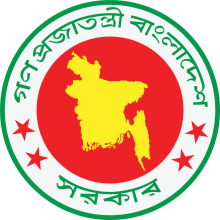
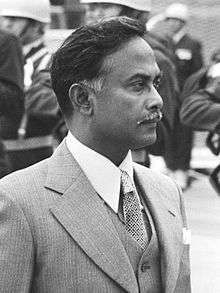

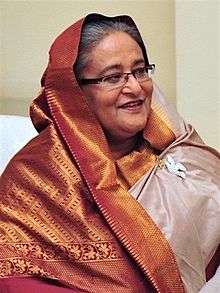
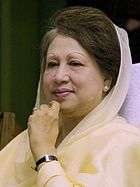
.jpg)
.jpg)


.jpg)

.jpg)
.jpg)
.svg.png)